 Lesser Black-backed Gull- Kleine Mantelmeeuw (graellsii & intermedius)
Lesser Black-backed Gull- Kleine Mantelmeeuw (graellsii & intermedius)
(last update:
lbbg 1cy May
lbbg 1cy June
lbbg 1cy July
lbbg 1cy August
lbbg 1cy September
lbbg 1cy October
lbbg 1cy November
lbbg 1cy December
lbbg 2cy January
lbbg 2cy February
lbbg 2cy Mar-April
lbbg 2cy May
lbbg 2cy June
lbbg 2cy July
lbbg 2cy August
lbbg 2cy September
lbbg 2cy October
lbbg 2cy Nov - Dec
lbbg 3cy Jan-April
lbbg 3cy May
lbbg 3cy June
lbbg 3cy July
lbbg 3cy August
lbbg 3cy September
lbbg 3cy October
lbbg 3cy Nov - Dec
lbbg sub-ad Jan-April
lbbg sub-ad May
lbbg sub-ad June
lbbg sub-ad July
lbbg sub-ad Aug
lbbg sub-ad Sept
lbbg sub-ad Oct
lbbg sub-ad Nov
lbbg sub-ad Dec
lbbg ad January
lbbg adult February
lbbg adult Mar
lbbg ad April
lbbg adult May
lbbg adult June
lbbg adult July
lbbg ad August
lbbg ad September
lbbg ad October
lbbg ad Nov - Dec
adult Lesser Black-backed Gull: April
Colony at "quai de la loire" at Calais, NW France. This is a mixed colony of Lesser Black-backed Gulls and Herring Gulls, with Lesser Black-backeds dominating. Theer are now about 200 pairs breeding. Picture from April 14 2014 (Jean-Michel Sauvage).
 |
 |
 |
 |
 |
 |
 |
 |
 |
 |
 |
 |
 |
 |
 |
 |
 |
 |
 |
 |
 |
 |
 |
 |
 |
 |
 |
 |
 |
 |
 |
 |
 |
 |
 |
 |
 |
 |
 |
 |
 |
 |
 |
 |
 |
 |
 |
 |
A historical ecology of two closely related gull species (Laridae): multiple adaptations to a man-made environment
 A historical ecology of two closely related gull
A historical ecology of two closely related gull
species (Laridae):
multiple adaptations to a man-made environment
- by: Kees (C.J.) Camphuysen -
Ph.D.-thesis, University of Groningen, Groningen, The Netherlands, June 2013
Full PDF by clicking image.
Appendix 6 ‐ Annual adult survival, recruitment and parental investment
Annual adult survival
While the fledging rates of Herring Gulls (0.88 ± 0.29 fledglings pair-1) found in Kelderhuispolder
were considerably higher than those of the sympatric Lesser Black-backed Gulls (0.49 ± 0.17; t
12
= -3.07, P< 0.01, two-tailed), our own colony censuses (2009 - 2011) indicated a continuing
decline in breeding numbers of the former and an increase in the latter species (Appendix 3). Part
of the explanation was expected to be found in species-specific differences in annual survival, the
age of first breeding and the actual numbers of recruits returning to breed. Data available on
fecundity and adult survival in several seabird populations suggest a negative relationship between
the two (Weimerskirch 2002). Devoting more energy per individual parent to the raising of young
would come at the expense of adult survival (Clutton-Brock 1988, 1991, Pyle et al. 1997). The
shape of this relationship is convex (App Fig. 6.1; repeated below), similar to the classical figure representing the
optimisation of the trade-off between survival and fecundity or other vital rates (Cody 1966). Cody
(1966) proposed a model in which by the "Principle of Allocation" maximum contribution to future
generations would be achieved by those individuals which utilise, to increase K (carrying capacity),
some of the energy conserved by reducing r (the reproductive rate; Williams 1966, Nur 1984).
The apparent survival and fecundity of both species is described in Chapter 7. Apparent survival (i.e. survival confounded by permanent emigration), investigated on the basis of the colour-ring programme, amounted to a mean of 79% in female and 86% in male Herring Gulls. Additive year effects rather than sex provided highest model support in Lesser Black-backed Gulls, in which apparent survival for both sexes combined varied between 81% and 100% (mean ≈91%). Given the observed population trends, the lower apparent survival in Herring Gulls than in Lesser Blackbacked Gulls found in this study did not come unexpected. An inverse relationship between annual apparent survival and fecundity was indeed found in Lesser Black-backed Gulls (Chapter 7). Herring Gulls, with their consistently lower survival rates, showed a consistently higher fecundity than Lesser Black-backed Gulls (App Fig. 6.1).
 Fig. 6.1 Hypothetical relationship between fecundity and survival in Laridae to achieve a constant population growth rate (λ), a convex curve representing optimisation between survival and fecundity (Cody 1966, Weimerskirch 2002). The plotted values are mean fecundity versus mean apparent annual adult survival for gulls breeding in Kelderhuispolder, 2006-2011. |
Recruitment and the Balance Per Annum
Levels of recruitment were thus far rather low in the Kelderhuispolder. Breeding birds with immature plumage characteristics are rare in these colonies, notably in Lesser Black-backed Gulls, suggesting that current recruits are at least 4 years old (5cy). Some estimates of recruitment rates are required to be able to calculate (or even just estimate) the Balance Per Annum (BPA; the difference between the number of chicks per pair surviving to breeding age and the number of adults dying per pair per year; Birkhead & Sears in Perrins 1991).
Between 2006 and 2011, 554 chicks of Lesser Black-backed Gulls and 237 chicks of
Herring Gulls were colour-ringed around fledging (c. 40d of age). Of the first three cohorts (2006-2008), 254 and 114 chicks respectively could have reached breeding age (5cy) during the period
described in this thesis. In fact, only 20% of the chicks (51 out of 254) of Lesser Black-backed
Gulls and 13% of Herring Gulls (15 out of 114) were demonstrated to have reached that age
(App Table 6.1). Based on a mean fledging rate of 0.49 fledglings pair-1 (Table 2.1, Appendix 3), the
number of Lesser Black-backed Gulls reaching a reproductive status (≥5cy) was thus 0.10 chicks
pair-1. Based on a fledging rate of 0.88 fledglings pair-1 in Herring Gulls, a marginally higher 0.12
chicks pair-1 was found. Considering an annual adult mortality of 0.18 adults pair-1 (Chapter 7) in
Lesser Black-backed Gulls, the BPA would be -0.08. With the considerably higher adult mortality of c. 0.35 adults pair-1 (annual survival 82.5%), the BPA for Herring Gulls would be -0.23. Both
populations may be considered unstable or declining, but the former mainly as a result of low
reproductive success, the latter mainly as a result of lower annual survival. Rather few "recruits" (that includes prospecting birds and only few confirmed breeders) have been demonstrated to have returned to the Kelderhuispolder colonies: 5% of all colour-ringed fledglings of Lesser Blackbacked Gulls and 4% of all Herring Gulls. If recruitment was based only on these birds, the BPA
would be considerably lower, but it is unlikely that all recruits are detected. Further evidence
showing that chicks raised at Texel recruit at a relatively high age (if at all) is provided in the
comparison of re-sightings within the colonies at Texel and at IJmuiden (AppTable 6.2).


Age composition – Though breeding attempts of birds in immature plumage may be fairly
common in certain (developing) mainland colonies in The Netherlands, the mean age of first
breeding in Herring Gulls is normally probably around 5 or 6 years of age (Vercruijsse 1999). In a
dense colony at the Isle of May (Scotland), no 4cy birds (3 yrs of age) were found holding
territories or breeding in the 1970s, but some 5cy gulls (4 yrs old) did (Chabrzyk & Coulson 1976).
For the Isle of May, it was estimated that the mean age of first breeding was 5.25 years, with 55%
of the birds breeding for the first time when five years (6cy) old.
The age composition of the breeding population at Texel is largely unknown, but early
recruits (or even immature visitors) in the colony are rare. All Lesser Black-backed Gulls that had
been ringed in other colonies and that were found to breed in the Kelderhuispolder in recent years
were fairly old (9-17 yr). Despite considerable observer effort, only six Lesser Black-backed Gulls
that had fledged between 2006 and 2009 were confirmed to have returned to nest and actually
breed in Kelderhuispolder, while there are four birds that have moved and recruited and bred
elsewhere. The much higher return rates in IJmuiden of prospecting birds are particularly striking, and prospecting or settling recruits are also younger at this mainland colony and first-year survival
was higher. Of 152 ringed chicks of Lesser Black-backed Gulls and 44 chicks of Herring Gulls, at
least 38 resp. 35% survived its first year against 29% and 26% at Texel (AppTable 6.1). To
compare the returns of potential recruits in the two colonies for the exact same period (ringing
effort 2008-11 versus ring-reading in 2009-2012):

Immigration, emigration
With respect to immigration and emigration (or colony dispersal), only anecdotal information is available, again on the basis of ringing data, but this time including some metal-ringed individuals. Within the Kelderhuispolder, adult breeding birds have been encountered that were ringed as fledglings in Orfordness (UK), Zeebrugge (B), Europoort/Maasvlakte and IJmuiden (mainland NL) and from other colonies at Texel. Birds that fledged at Texel in recent years have been found as prospecting individuals at Trischen (Wadden Sea FRG) and Vlieland (Wadden Sea NL), and as confirmed breeders in Zaandam and IJmuiden (mainland NL).
Immigration - Two Lesser Black-backed Gulls ringed as chicks in IJmuiden have recruited in the Kelderhuispolder colonies, 11 individuals originated from Europoort/Maasvlakte, and two from Orfordness (Suffolk, UK) (AppFig. 6.2). All these birds had been ringed as chicks between 1988 and 1997 and were between 9 and 17 years of age (mean 14.3 yrs) when detected as breeding birds at Texel. A recent exception is a bird ringed as chick in Zeebrugge (Belgium) that recruited in the Kelderhuispolder at an age of 5 years, after a prospecting visit one year earlier.
Emigration - Seven Lesser Black-backed Gulls ringed as young birds since 2006 at Texel have been seen prospecting or were demonstrated to breed in other colonies: K.BAU (Trischen, FRG), K.FAU (IJmuiden, Forteiland), K.LAC (Vliehors, Vlieland), K.NAP (Achtersluispolder Zaandam), P.CAC (IJmuiden, Forteiland), P.CBU (IJmuiden, Forteiland), and P.CDV (Vliehors, Vlieland). Of these, at least three have bred: KFAU (2011-12), KNAP (2011-12), and PCBU (in 2011, prospecting in 2012).

Fig. 6.2 Links between de Kelderhuispolder colony and other Lesser Black-backed Gull colonies based ringed and colour-ringed individuals ringed at Texel and elsewhere.

Trends and seasonality in mortality as derived from beached bird surveys
Mortality is an aspect that is notoriously difficult to study during colony work. Birds sometimes
disappear, but in the absence of physical evidence, anything could have happened. Since large
gulls are coastal seabirds, some insight in seasonal as well as annual patterns and trends in
mortality can be evaluated on the basis of beached bird surveys (>50 yrs of data). The data were
used to investigate the age composition and the overall densities of dead gulls on the North Sea
coastline, in order to check if mortality levels may have changed in recent years. Many fledglings
fail to really leave the colony area, but fledglings from coastal colonies (such as those at Texel)
often die on the nearby beaches, during attempts to find some food or on the beach roosts where
they mix with moulting adults. Beached bird surveys could therefore be a useful tool to quantify
seasonal patterns in mortality.
We have seen that the incidence of oil pollution in Herring Gulls has declined significantly
over the years (Appendix 2, AppFig. 2.13) and currently, most gulls die from 'natural causes'
(disease, starvation), or from entanglements in plastics or fishing gear or other accidents. We
have also seen that the annual cycle and the migratory movements in autumn (or post-breeding
dispersal) make that the composition of the population of gulls utilising Dutch nearshore water and
on our beaches will change (Appendix 4): there are no or few "local" Lesser Black-backed Gulls in
winter (because all these birds are in Portugal and Spain). Although many Dutch Herring Gulls remain here in winter (Appendix 5), their numbers will be augmented by birds from a Baltic,
Scandinavian or German origin. This should be kept in mind when consulting the results from
beached bird surveys over time.
In App Fig. 6.3 the monthly densities of dead gulls are provided for each of the years of
study (2006-12) against a background of "historical" densities based on surveys between 1980
and 2005. From the material provided in Appendix 2 it is obvious that the breeding population of
Lesser Black-backed Gulls increased by a factor 7.5 between 1980 and 2005, whereas that of
Herring Gulls peaked reduced in the same period by 25%. Current densities were therefore much
higher than 'historical ones' in Lesser Black-backed Gulls, while the reverse was true for Herring Gulls. Both species have a late summer peak in densities, which was however more prominent in
the historical data of Herring Gulls than it is nowadays. In recent years as well as historically,
densities of stranded Lesser Black-backed Gulls increased from April to July followed by a decline.
Very low numbers (as expected) are found in winter (Nov-Mar). From April through July, it is
mostly adult birds that are found, while juveniles start to predominate in August-October. Over the
years, the age composition of the stranded animals remained more or less the same, but current
densities are higher (AppFig. 6.4). A similar trend was found in Herring Gulls, except that first year birds remain numerous throughout the winter and into spring (AppFig. 6.5). Juveniles predominated
in Aug-Oct, but in June and certainly in July proportionally many adult gulls were found. Recent
winters have been relatively mild (AppFig. 2.8), despite some spells of cold weather, and winter
mortalities will therefore have been suppressed (AppTable 2.3).


Fig. 6.3 Annual monthly densities of dead Lesser Black-backed Gulls (A) and Herring Gulls (bottom) along the North Sea shoreline, based on beached bird surveys 2006-2012 against the longterm mean densities found during beached bird surveys 1980-2005 (average ± SE); NZG/NSO beached bird surveys, unpubl. data; based on 7741counts covering 45,243 km, retrieving corpses of 1817 Lesser Black-backed Gulls, and 15,842 Herring Gulls.


Fig. 6.4 Monthly densities of dead Lesser Black-backed Gulls (A) and Herring Gulls (B) along the North Sea shoreline, based on beached bird surveys 1980-2005 and 2006-2012 (average ± SE) and the proportion (%) of first year birds found dead; NZG/NSO beached bird surveys, unpubl. data.
Intermittent breeding
Extensive ring-reading activities in the prospecting and early breeding phase resulted in high
numbers of re-sightings of birds ringed as breeding birds in previous seasons, with few exceptions
at or near the exact same territories as in earlier seasons. However, not all returning birds could
subsequently be demonstrated to breed. Some failures to confirm breeding were resulted from
difficulties to read rings in vegetated or 'hilly' terrain (steep dunes, esp. in the prime Herring Gull
habitat). Confirmed breeding attempts of returning adults were consistently scarcer in Lesser
Black-backed Gulls than in Herring Gulls (46% in LBBG, 63% in HG; AppTable 6.3).
"Not breeding" is more difficult to confirm than "breeding", but the difference between the
species is considerable in all seasons with sufficient data (AppFig. 6.4). Site-fidelity is such that
breeding attempts elsewhere in the colony are unlikely (5 cases have been documented within the
colony, 2007-2012; these involved moves from monitored study plots to nearby nesting habitat
just beyond the study areas). The percentage (%) of prospecting birds in which breeding was
subsequently confirmed is used here to indicate the "breeding incentive", or the drive to breed in a
given season. Some birds skipped one, two or even three years and re-appearances as breeding
birds were typically very close to or exactly at the original nesting site (certainly in males; divorced
females usually moved to another territory). Lesser Blacked-backed Gulls were slightly more
frequently found to skip breeding seasons (22% of 208 confirmed re-breeding cases were after
one or more years of non-breeding, against 15% in Herring Gull, n= 166; AppTable 6.3). Skipping
two or more seasons was fairly rare in Herring Gulls (1%, n= 166), slightly commoner in Lesser
Black-backed Gulls (6%, n= 208).
Most of the prospectors that could not be confirmed as breeding birds disappeared from
the colony after early May (some returned in July and August). In Lesser Black-backed Gulls (not
in Herring Gulls), breeding confirmations (%, AppTable 6.4) and the onset of laying (date, timing,
Table 2.1) were negatively correlated: non-breeding (of earlier established breeding birds) tended
to be more frequent in delayed seasons (RS
= -0.90, n= 5). The data series is too short, however,
to draw firm conclusions. A low frequency of breeding confirmations was particularly striking in
2012, a season with a much delayed onset of breeding. Only 25% of the prospecting Lesser Blackbacked Gulls were found breeding later in that season. In Herring Gulls, reproductive success
(fledglings pair-1, Table 2.1) and the proportion of confirmed breeding attempts by prospecting
individuals were positively correlated (RS
= 0.80, n= 5).
As a result of the difficult terrain the Herring Gulls were nesting in, it was easier to read rings of Lesser Black-backed Gulls at their nest. The difference between the species in apparent non-breeding by prospecting adults (AppTable 6.4) may therefore be larger than indicated. At the nearby mainland colony Forteiland in IJmuiden, where nest initiations are earlier than at Texel and where fledging rates are seemingly higher (no concrete data available, just a visual impression), the same colour-rings have been deployed since 2008. Of colour-ringed Lesser Black-backed Gulls returning and prospecting in IJmuiden during 2009-2012, 55.7±10.3% were demonstrated to breed (Texel 2009-2012 46.8±15.8%, AppTable 6.4). Of Herring Gulls returning in IJmuiden, 61.7±12.3% were found breeding (Texel 66.3±11.4%). These values are of the same order of magnitude as those on Texel, even though providing evidence that birds were breeding is far more easy at IJmuiden than at Texel. The results suggest that Lesser Black-backed Gulls at Texel breed on average once every 2.1 years, those in IJmuiden every 1.8 yrs. For Herring Gulls, a highly similar breeding frequency of once every 1.5 (Texel) to 1.6 years (IJmuiden) can be estimated.

Table 6.3. Confirmed breeding in prospecting colour-ringed Lesser Black-backed Gulls (LBBG) and Herring Gulls (HG) in Kelderhuispolder (Texel). Shown are the number of colour-ringed individuals that returned as prospecting birds, the number and percentage in which breeding was subsequently confirmed, and the frequency of season skipping.

Table 6.4. Annual variations in "breeding incentive": the proportion of prospecting colour-ringed Lesser Blackbacked Gulls (LBBG) and Herring Gulls (HG) in Kelderhuispolder (Texel) that were later that season recorded as confirmed breeding birds. Shown are the observer effort (hours in the field prior to 10 May to record prospecting birds and the hours spent during breeding), the ringing cohorts evaluated, and for each species the number of colour-ringed prospecting birds (obs), and the number (br) and the breeding incentive (%).
Parental care and the need for a break - Cody's (1966) model, in which annual survival (and thereby future reproductive success) would be enhanced by those individuals which conserve energy by reducing the current reproductive rate, became again of interest when highly unusual foraging trips were evaluated in the course of a GPS tracking study of Lesser Black-backed Gulls from Kelderhuispolder (Chapter 8). Tracking studies of seabirds occasionally reveal exceptionally long or distant foraging trips. The characteristics, the frequency, and the possible triggers of such unusual trips in comparison to thousands of other, more regular trips were considered in the context of reproductive performance and chick growth. The hypothesis that exceptional trips were conducted exclusively by failed breeders, but not by active breeders during incubation or chick care, had to be rejected. Exceptionally long and distant trips occurred irregularly but annually, in many individual birds and in all phases of breeding, except that in active breeders such trips were relatively rare when the chicks were still young and highly vulnerable (<10d of age). The data seem to suggest that additional time for individual maintenance (e.g. self-provisioning, replenishing exhausted resources) rather than extra effort in chick provisioning (a chick starvation hypothesis) was the most important factor. During a breeding attempt, in other words, apart from giving up, individual birds apparently stepped back and reduce their efforts to enhance their own condition (and fitness). The beached bird survey results suggest that an "untimely death" for an adult in the breeding period is far from unlikely. The individual breaks in chick care were potentially at the expense of clutch or chicks, and compensatory behaviour of the partner was required to bring the breeding attempt to a successful end. The reproductive success in birds that performed exceptional trips was rarely compromised, suggesting that mates compensated indeed for these absences.
Post-fledging chick mortality – Vercruijsse (1999) reported the annual survival and recruitment
rates of young Herring Gull at Schouwen (Delta area), following the colour-ringing campaigns in
1986-1988. Of 314 fledglings ringed at Schouwen, 37% were demonstrated to be alive
after one year (re-sightings in later years, no corrections for detection probabilities). Using the
same technique at Texel in 2006-12, the mean first-year survival of Herring Gull chicks ringed at
Texel (2006-2011) was a rather lower 25±6%, that of 554 Lesser Black-backed Gull chicks from
Texel amounted to 31±7% (AppTable 6.1). First year mortality of fledglings, based on demonstrated survival ranged from 70-85% in Herring Gulls and 58-79% in Lesser Black-backed
Gulls The annual mortality in subsequent years was considerably lower.
Annual survival rates after the first year of life (2-5 yrs of age, just prior to expected
recruitment) in Herring Gulls from Schouwen in the late 1980s and early 1990s were high and
averaged 87.5±1.0%. Immature Herring Gulls from Texel scored a considerably lower and more
variable annual survival of 70.0±5.8%. The annual survival of immature Lesser Black-backed Gulls
from Texel (82.5±5.2%; AppFig. 6.5) was more or less similar as that in Herring Gulls from
Schouwen some decades earlier.

Fig. 6.5 Percentage decline in the number of Herring Gulls (HG) and Lesser Black-backed Gulls (LBBG), ringed as chicks in Schouwen (Sch1986-Sch1988, Herring Gulls only; data from Vercruijsse 1999) or at Texel (2006-2009) after the first year of life (i.e. after the relatively high losses in the juvenile phase).
End Of Appendix 6 ‐ Annual adult survival, recruitment and parental investment
Below: images of birds from the Netherlands, first week of April 2017. |
|
 |
 |
 |
 |
 |
 |
 |
 |
 |
 |
 |
 |
 |
 |
 |
 |
 |
 |
 |
 |
 |
 |
| Set of early April adult Lesser Black-backed Gulls in Leiden, the Netherlands. Roof top breeders here. LBBG graellsii in spring: open wings. |
|||
 |
 |
 |
 |
 |
 |
 |
 |
 |
 |
 |
 |
 |
 |
 |
 |
 |
 |
 |
 |
LBBG returning to the colonies in the Netherlands
![]() End of
March; many adult LBBG of the Maasvlakte (see
map) already return
to the breeding grounds and try to find nesting locations in the colonies.
Successful adults are very faithful to nesting locations and partners and
can be found breeding on exactly the same spot (inch-perfect!) year after
year. Adult males, returning early in the colony normally wait for the
same partner, establishing dominance over a last-year's successful
territory. If the female arrives later in the season, other female try to
mate with such dominant males, but once his partner arrives, the bond will
soon be established and those (often young) females are kicked out the
territory.
End of
March; many adult LBBG of the Maasvlakte (see
map) already return
to the breeding grounds and try to find nesting locations in the colonies.
Successful adults are very faithful to nesting locations and partners and
can be found breeding on exactly the same spot (inch-perfect!) year after
year. Adult males, returning early in the colony normally wait for the
same partner, establishing dominance over a last-year's successful
territory. If the female arrives later in the season, other female try to
mate with such dominant males, but once his partner arrives, the bond will
soon be established and those (often young) females are kicked out the
territory.
By the end of March, 1.000s of LBBG (probably mostly originating from intermedius populations in Scandinavia) migrate east-northeast along the coast-line
of the Netherlands and make short stop-overs at the beach. Well over 90% of the birds
are adults and trains of birds glide motionless over the beaches of the
Wadden Isles into the Danish Wadden Sea.
 LBBG, April 16 2001, Nachtegalenkeet Maasvlakte, the Netherlands. An image showing the difference in grey tones between two
adult LBBG, breeding in the Netherlands. LBBG, April 16 2001, Nachtegalenkeet Maasvlakte, the Netherlands. An image showing the difference in grey tones between two
adult LBBG, breeding in the Netherlands. |
At the Maasvlakte, most major position are taken again in the colony by another
type of LBBG: Dutch intergrades. The are slightly darker than typical graellsii from Britain, but not as dark as the average intermedius from
Scandinavia. They carry the genetic heritage of both taxa. The exchange of
gene pools hasn't stopped yet. Still, in the colonies at Maasvlakte we see
foreign ringed birds, breeding together with local Dutch birds. Not
surprising, these foreign birds often seem to be females.
In the mean time birds born in colonies at Maasvlakte spread to other
colonies abroad as well. The very prosperous colony at the Belgium port of
Zeebrugge was initiated by both British and Dutch LBBG, as several colour-ringed
birds proved.
Primary Moult Scores in adult LBBG:
Year 2003 we did some preliminary research on primary moult scores in adult LBBG. In total, we scored about 1400 birds from early April to mid October. This research will be used to do some more fundamental research in tear 2003-2004. First results for April are quite simple: we scored 49 birds on April 05 and we scored 45 birds on April 19. All these birds had P1 still present, hence PMS = 0. Nevertheless we did see several adult LBBG in the colony, which had P1 shed by April 19. Some notes: the scorse on April 05 2003 were done at Naaktstrand, on preening, bathing and arriving birds, through 20x-60x telescopes. Active moult would be noticed, but to detect arrested moult in such circumstances is pretty difficult. Next year, we try to start our surveys with catching birds and examine the exact primary stage in the inner primaries by taking photographs.
Tables & Graph
Table below: data for the Netherlands (2000-2010), results for April (aggregated week): number of remaining old primaries in adults.
REM10 = 10 primaries still old (hence, complete moult not started yet). First signs of complete moult commencement in WEEK 18 (starting 30 April).
| starting date:
|
|
|
16 Apr | 23 Apr | 30 Apr |
|
| week no:
|
9
|
14
|
16
|
17
|
18
|
19
|
| REM 0
|
0
|
0
|
0
|
0
|
0
|
0
|
| REM 1
|
0
|
0
|
0
|
0
|
0
|
0
|
| REM 2
|
0
|
0
|
0
|
0
|
0
|
0
|
| REM 3
|
0
|
0
|
0
|
0
|
0
|
0
|
| REM 4
|
0
|
0
|
0
|
0
|
0
|
0
|
| REM 5
|
0
|
0
|
0
|
0
|
0
|
0
|
| REM 6
|
0
|
0
|
0
|
0
|
0
|
0
|
| REM 7
|
0
|
0
|
0
|
0
|
0
|
0
|
| REM 8
|
0
|
0
|
0
|
0
|
15
|
11
|
| REM 9
|
0
|
0
|
0
|
0
|
40
|
34
|
| REM 10
|
2
|
49
|
45
|
1
|
466
|
216
|
|
|
|
|
|
|
|
|
| n =
|
2
|
49
|
45
|
1
|
521
|
261
|
| average P =
|
10.0
|
10.0
|
10.0
|
10.0
|
9.9
|
9.8
|
| 95% CID =
|
0.00
|
0.00
|
0.00
|
- | 0.04
|
0.06
|
| inverse =
|
12.71
|
2.01
|
2.02
|
- | 1.96
|
1.97
|
| Variantie (s2) =
|
0.00
|
0.00
|
0.00
|
- | 0.17
|
0.25
|
| SD (s) =
|
0.00
|
0.00
|
0.00
|
- | 0.42
|
0.50
|
| SE (sx) =
|
0.00
|
0.00
|
0.00
|
- | 0.02
|
0.03
|
|
|
|
|
|
|
|
|
| % class:
|
|
|
|
|
|
|
| 0
|
0
|
0
|
0
|
0
|
0
|
0
|
| 1
|
0
|
0
|
0
|
0
|
0
|
0
|
| 2
|
0
|
0
|
0
|
0
|
0
|
0
|
| 3
|
0
|
0
|
0
|
0
|
0
|
0
|
| 4
|
0
|
0
|
0
|
0
|
0
|
0
|
| 5
|
0
|
0
|
0
|
0
|
0
|
0
|
| 6
|
0
|
0
|
0
|
0
|
0
|
0
|
| 7
|
0
|
0
|
0
|
0
|
0
|
0
|
| 8
|
0
|
0
|
0
|
0
|
3
|
4
|
| 9
|
0
|
0
|
0
|
0
|
8
|
13
|
| 10
|
100
|
100
|
100
|
100
|
89
|
83
|
|
|
|
|
|
|
|
|
|
|
100
|
100
|
100
|
100
|
100
|
100
|
.

Above: Scatter Plot for PMS in adult Lesser Black-backed Gulls. Number of remaining old primaries throughout the year (arrested moult excluded). Sample size is 6.171 birds.
Above: Scatter Plot for PMS in adult Lesser Black-backed Gulls. Number of remaining old primaries for April (arrested moult excluded). Sample size for this graph is 879 ringed birds.
starting date:
|
30 Apr
|
07 May
|
week no:
|
18
|
19
|
NEW 0
|
457
|
205
|
NEW P1
|
10
|
3
|
NEW P2
|
3
|
1
|
NEW P3
|
0
|
0
|
NEW P4
|
0
|
0
|
NEW P5
|
0
|
0
|
NEW P6
|
0
|
0
|
NEW P7
|
0
|
0
|
NEW P8
|
|
0
|
NEW P9
|
|
|
NEW P10
|
|
|
|
|
|
n =
|
470
|
209
|
average NEW P =
|
0.0
|
0.0
|
95% CID =
|
0.02
|
0.02
|
inverse =
|
1.97
|
1.97
|
Variantie (s2) =
|
0.05
|
0.03
|
SD (s) =
|
0.21
|
0.18
|
SE (sx) =
|
0.01
|
0.01
|
|
|
|
% class
|
|
|
0
|
97
|
98
|
1
|
2
|
1
|
2
|
1
|
0
|
3
|
0
|
0
|
4
|
0
|
0
|
5
|
0
|
0
|
6
|
0
|
0
|
7
|
0
|
0
|
8
|
0
|
0
|
9
|
0
|
0
|
10
|
0
|
0
|
|
|
|
% control:
|
100
|
100
|
Table above, data for the Netherlands (2000-2010), results for April (aggregated week): number of new, fully grown primaries in adults.
NEW0 = no new primaries visible (arrested moult excluded in this analysis). So either P1 still old, or P1 dropped, but the very tip still not visible.
NEW1 = P1 longest new primary. Range between "at least the tip of P1 is visible" until "tip of P2 still shorter than P1".
NEW2 = P2 longest new primary. NEW3 = etc.

Above: Scatter Plot for PMS in adult Lesser Black-backed Gulls. Longest new primary is classified "fully grown". Sample size is 2.969 birds. Birds scored on NEW primaries (arrested moult excluded).
The last scoring days were in November, with a larger sample (133 adults) on 04 November 2010. From that date we have the last birds with retaining old primaries (13 birds with 1, 2 or even 3 old primaries; 120 birds with no old primaries left). From other days in November, only 10 birds were scored (all ringed adults). They all had no old primaries left.
The first tine a new primary (P1) was visible, was on 08 May 2006. Prior to this date, birds were scored missing inner primaries, but the very tip was still not visible (and therefore not scored). As soon as the tip of P1 was visible, this was automatically scored "fully grown" For the other primaries to be scored fully grown, they had to exceed the previous primary in length (so P2 fully grown, only from when it is longer than P1).
|
Netherlands
|
|
||||
|
PMS range
|
N:
|
Average PMS
|
PMS range
|
N:
|
Average PMS
|
1-15 apr
|
10
|
49
|
10
|
8-10
|
216
|
9,9
|
16-30 apr
|
10
|
47
|
10
|
10
|
197
|
10,0
|
1-15 may
|
8-10
|
849
|
9,8
|
8-10
|
167
|
9,9
|
16-31 may
|
7-10
|
380
|
9,7
|
7-10
|
76
|
9,5
|
1-15 jun
|
8-10
|
104
|
9,6
|
7-10
|
33
|
8,6
|
16-30 jun
|
7-10
|
253
|
9,7
|
6-10
|
65
|
8,2
|
1-15 jul
|
6-10
|
605
|
9,2
|
5-10
|
176
|
7,4
|
LINEAR REGRESSION
Onset of primary moult can best be illustrated by a sinusoid for the first few weeks and last weeks, but there appears to be linear dependency over much of the central moult period.
The earliest date for birds with missing primaries is 30 April 2006, which is not the earliest day in our complete sample. We scored 98 Lesser Black-backed Gulls prior to that date, some already in February. As can be expected, none of these was in primary moult, and this group was excluded in our further analysis as it will only result in a misfit for the onset of moult, using linear regression statistics.
LINEAR REGRESSION FOR OLD REMAINING PRIMARIES
Complete sample: Linear regression (n = 6171, R2= 0.820, sign: P<0,000)
PMS = -0,381* WEEK + 17,967
Ringed adults: Linear regression (n = 2069, R2= 0.800, sign: P<0,000)
PMS = -0,325* WEEK + 16,270
Unringed adult: Linear regression (n = 4102, R2= 0.779, sign: P<0,000)
PMS = -0,513* WEEK + 23,031
LINEAR REGRESSION FOR NEW FULLY GROWN PRIMARIES
Complete sample: Linear regression (n = 2969, R2= 0.930, sign: P<0,000)
PMS = 0,302* WEEK - 5,933
Ringed adults: Linear regression (n = 1209, R2= 0.888, sign: P<0,000)
PMS = 0,252* WEEK - 4,747
Unringed adult: Linear regression (n = 1760, R2= 0.833, sign: P<0,000)
PMS = 0,442* WEEK - 11,906
| April 05 2003: Primary moult scores (PMS) in ringed adult LBBG, Naaktstrand, Maasvlakte, the Netherlands (resting group outside colony). | |
| PMS 0 | n: 49, location Naaktstrand |
| green rings:
E762, E800, E887, E935, EAH0, ECJ1, EP63, EP70, ER51, ES08, EU74,
EU85, EV54, EX01, KR9, KX2, NC0, PP5, RH1, RM1, RP7, TN9. left + right rings: H black + 4 white, J green + 7 black, Y green + 1 black. orange rings: E017, E159, E264, E448, E623, E678, E702, E818, E919, EAY0, EJ06, EJ23, EJ98, EM7, EN84, EP??, ES08, EV54, EV60, JX5, KK6, LC1 orange rings with white code: NU8 white rings: M69 |
|
| April 19 2003: Primary moult scores (PMS) in ringed adult LBBG, Naaktstrand, Maasvlakte, the Netherlands. Location: Maasvlakte & Dintelhaven. | |
| PMS not noted, n: 12 | PMS 0, n: 45 |
| green rings: E02?, EA01, EAM4, EE03, EX04, PR9, UK2. orange rings: EAS8, EM4?. white rings: RU8, SL2, ? E. |
green rings: AX5, E108, EA2, EAC2, EH6, EH94, EP60, ER55, ES98,
ET37, ET79, EV39, EY03, EY16, JC8, JH5, JM0, JN9, JY2, LC9, LL6,
PP0, RR0, UK0, UY4. orange rings: E274, E818, EC40, EE53, EJ06, EJ98, EL10, EP94, ET57, EU69, EY68, KK6, LC1, RU9, UC6. orange rings with white code: RJ5 red rings: ALH. metal rings: GG93433, 5.3xx.xxx, NLA old. |
LBBG in the Netherlands: colour ring projects
For over 10 years we have colour ring projects in the Netherlands. By far the largest project involves LBBG breeding in two colonies near the port of Rotterdam: one large colony at Maasvlakte and the second at Dintelhaven (eastern Maasvlakte). Although the other colony is well visible from either side, only separated by water, birds appear to be very faithful and try to nest in the colony where they were raised. Only limited number of ringed birds can be found in the 'wrong' colony.
First LBBG were ringed with white rings,
first with letter digit digit, later with letter letter digit.
At the colony 'Maasvlakte', orange rings were used. First years
(1991-1992) codes were letter digit digit, later letter letter
digit. From then on, all ring codes started with E (Europoort
Rotterdam), followed by three letters or digits.
At the colony of 'Dintelhaven' green rings were used, the same repertoire.
In the right column of this page you can find some examples of ringed
adult LBBG from both locations.
At
the port of IJmuiden, near Amsterdam, Fred Cottaar started another LBBG
colour ring project on roof top breeding birds. In this project, red and
white rings were used with three different codes: a single letter or
single digit or bars.
Such codes can also be found on other colours, originating from the isle
of Texel, the Netherlands.
Recently, Fred Cottaar caught adult LBBG on the nest and they received red
rings, starting with E and followed by three digits.
Another recently started colour-ring project in the Netherlands can be found in the industrial area of Moerdijk (inland breeding LBBG). This project was started by Roland-Jan Buijs and he used mint green rings with two black letters. Because this population breeds in tall grass, Roland-Jan used tibia rings.
Subsequently, an interesting English project was started by David Sowter in 1997.
Use of colour rings to study inter-colony movement and feeding of Lesser Black Backed Gulls at three sites in NW England.
by: David Sowter
Purpose:
Despite regular culling and disturbance the Lesser Black Backed Gull colony at Tarnbrook Fell has continued to thrive. This study is intended to determine the extent to which movement of Lesser Black Backed Gulls between the three sites, which are inter-visible on a good day, may play a part in the breeding success of the Tarnbrook colony. It is also hoped to establish whether there are common feeding, roosting and migration sites and what part they play in the movement of gulls between colonies for breeding.
Method:
In the pilot year, 1997, 200 juveniles were ringed at each of the three sites using green darvic with a single white letter code: R, T, and W. For each of the five years 1998- 2001, 2500 birds will be ringed at each of the three sites with black darvic rings with yellow site letter plus a three letter/number combination (left leg) so individual birds can be identified in the field by year and site. Individual BTO metal rings (right leg) will also identify birds.
To develop and analyze data based on personal observation and records achieved through co-operation with local bird clubs and through the BTO network and the large gull coordinator, Peter Rock.
Sites:
Ribble Estuary Nature Reserve: ( 53 42’ N : 2 55’ W - SD 3924) in co-operation with Mike Gee/Dick Lambert, English Nature Wardens and SW Lancs Ringing Group. Dick and the SW Lancs Ringing Group have carried out some ringing for most years since the mid-1980’s. The site is within salt marsh near the mouth of the River Ribble and is subject to periodic flooding by high tides, which decimates the breeding success in some years.
Tarnbrook Fell, Forest of Bowland: (54.01N 2.35W - SD 6258) with permission and sponsorship from Grosvenor Estates, Abbeystead and Mr R Banks the Abbeystead Estate manager; Mr R Challenor for Mallowdale estates and NW Water for Brennand estates. Dr John Coulson and associates have been undertaking studies and control measures at this site since at least the mid-1980’s. The colony, which is within heather, grass and peat-hag moorland at a height of 450-530 metres, has continued to maintain high numbers or expand despite culling and managed disturbance over a number of years.
South Walney Nature Reserve: (54.03N 3.12W - SD 2162) in co-operation with Rob Shaw and Nick Littlewood, the warden of the reserve. There has been ringing of gulls on this dune site at the south end of Walney Island since at least the early 1960’s.
Colour Ring combinations:
R is Ribble;
T is Tarnbrook Fell ;
W is Walney Island.
1997: GREEN showing WHITE single letter for site.
1998 - 2002: BLACK showing YELLOW 4 letter/number combinations.
Please send details of sightings with date, location, details of gulls and activity to:
David Sowter: 5 The Grove Penwortham Preston PR1 0UU. 01772 749220. davidsowter@freenet.co.uk
All responses will be acknowledged.
Especially these kind of project, with many LBBG colour ringed, may give full insight in variation of LBBG plumages from different locations. See also the Distribution Section.
Adult intermedius from Norway
.
 Lesser Black-backed Gull intermedius JHH7 7CY, April 07 2015, Matosinhos Beach, Matosinhos, Portugal. Picture: José Marques.
Lesser Black-backed Gull intermedius JHH7 7CY, April 07 2015, Matosinhos Beach, Matosinhos, Portugal. Picture: José Marques. Lesser Black-backed Gull 7cy J1PN April 11 2012, Outreau-Boulogne, NW France. Picture: Jean-Michel Sauvage.
Lesser Black-backed Gull 7cy J1PN April 11 2012, Outreau-Boulogne, NW France. Picture: Jean-Michel Sauvage. LBBG JK3S March 14 2010, Madrid, Spain. Photo by Delfín González.
LBBG JK3S March 14 2010, Madrid, Spain. Photo by Delfín González.Adult graellsii from Iceland.
 Lesser Black-backed Gull graellsii YK94 8CY, April 01 2015, Matosinhos, Portugal. Picture: José Marques.
Lesser Black-backed Gull graellsii YK94 8CY, April 01 2015, Matosinhos, Portugal. Picture: José Marques.Adult graellsii from the UK
.
 LBBG ALH April 19 2003, e-on, Maasvlakte, the Netherlands (51.59N 04.02E). Ringed in the U.K. now breeding in Holland.
LBBG ALH April 19 2003, e-on, Maasvlakte, the Netherlands (51.59N 04.02E). Ringed in the U.K. now breeding in Holland.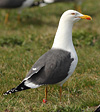 Lesser Black-backed Gull graellsii FLV 15CY-18CY, March 25 2012 & April 07 2015, Maasvlakte, the Netherlands. Picture: Merijn Loeve & Maarten van Kleinwee.
Lesser Black-backed Gull graellsii FLV 15CY-18CY, March 25 2012 & April 07 2015, Maasvlakte, the Netherlands. Picture: Merijn Loeve & Maarten van Kleinwee. Lesser Black-backed Gull graellsii 5cy & 9cy-11cy RXB August 2009, May 2013 - April 2015, Calais, NW France. Picture: Jean-Michel Sauvage.
Lesser Black-backed Gull graellsii 5cy & 9cy-11cy RXB August 2009, May 2013 - April 2015, Calais, NW France. Picture: Jean-Michel Sauvage. Lesser Black-backed Gull graellsii 4AX5 adult, March - December 2015, Matosinhos, Portugal. Picture: José Marques.
Lesser Black-backed Gull graellsii 4AX5 adult, March - December 2015, Matosinhos, Portugal. Picture: José Marques. LBBG BTO GG-93433 April 22 2002, Missouriweg - ECT, Maasvlakte, the Netherlands (51.59N,04.02E). Adult from Britain, now breeding in SW Holland.
LBBG BTO GG-93433 April 22 2002, Missouriweg - ECT, Maasvlakte, the Netherlands (51.59N,04.02E). Adult from Britain, now breeding in SW Holland. LBBG 19cy & 21cy BTO GG-49760 April-May 2012 & April 2014, Calais, NW France. Picture: Jean-Michel Sauvage.
LBBG 19cy & 21cy BTO GG-49760 April-May 2012 & April 2014, Calais, NW France. Picture: Jean-Michel Sauvage. Lesser Black-backed Gull graellsii BTO GG70601 27CY, June 26 2015, Leixões Harbour, Matosinhos, Portugal. Picture: José Marques.
Lesser Black-backed Gull graellsii BTO GG70601 27CY, June 26 2015, Leixões Harbour, Matosinhos, Portugal. Picture: José Marques. LBBG BTO FP-53854 April 26 2004, EMO - Maasvlakte, the Netherlands (51.59N 04.02E). Adult ringed in Britain, now breeding in SW Holland.
LBBG BTO FP-53854 April 26 2004, EMO - Maasvlakte, the Netherlands (51.59N 04.02E). Adult ringed in Britain, now breeding in SW Holland.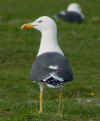 LBBG BTO FP-53605 April 05 2003, Nachtegalenkeet, Maasvlakte, the Netherlands (51.59N,04.02E). An adult ringed in Britain, now breeding in SW Holland.
LBBG BTO FP-53605 April 05 2003, Nachtegalenkeet, Maasvlakte, the Netherlands (51.59N,04.02E). An adult ringed in Britain, now breeding in SW Holland. Lesser Black-backed Gull 8cy-9cy FV 38253 June 2013 & April 2014, Calais, NW France. Picture: Jean-Michel Sauvage.
Lesser Black-backed Gull 8cy-9cy FV 38253 June 2013 & April 2014, Calais, NW France. Picture: Jean-Michel Sauvage. Lesser Black-backed Gull adult BTO FV38262 April 2012 & 2014, Calais, NW France. Picture: Jean-Michel Sauvage.
Lesser Black-backed Gull adult BTO FV38262 April 2012 & 2014, Calais, NW France. Picture: Jean-Michel Sauvage. Lesser Black-backed Gull 19cy & 21cy BTO GG49760 2012 & 2014, Calais, NW France. Picture: Jean-Michel Sauvage.
Lesser Black-backed Gull 19cy & 21cy BTO GG49760 2012 & 2014, Calais, NW France. Picture: Jean-Michel Sauvage.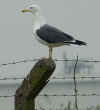 LBBG BTO GH-... , Dintelhaven, Maasvlakte, the Netherlands (51.59N,04.02E), March 30 2002. Now breeding in Holland.
LBBG BTO GH-... , Dintelhaven, Maasvlakte, the Netherlands (51.59N,04.02E), March 30 2002. Now breeding in Holland. LBBG BTO ?E-4678?, April 19 2002, Le Portel / Boulogne-sur-Mer, France (50.42N,01.34E). An adult bird with a British ring.
LBBG BTO ?E-4678?, April 19 2002, Le Portel / Boulogne-sur-Mer, France (50.42N,01.34E). An adult bird with a British ring.Adult graellsii from France
.
 Lesser Black-backed Gull 5,6,8cy 001N 2009, 2010 & 2012, Calais, NW France. Picture: Jean-Michel Sauvage.
Lesser Black-backed Gull 5,6,8cy 001N 2009, 2010 & 2012, Calais, NW France. Picture: Jean-Michel Sauvage. Lesser Black-backed Gull 4cy-5cy 020A May 2012 & April 2013, Calais, NW France. Picture: Jean-Michel Sauvage.
Lesser Black-backed Gull 4cy-5cy 020A May 2012 & April 2013, Calais, NW France. Picture: Jean-Michel Sauvage. Lesser Black-backed Gull 5cy 029A April, May & July 2013, Calais, NW France. Picture: Jean-Michel Sauvage.
Lesser Black-backed Gull 5cy 029A April, May & July 2013, Calais, NW France. Picture: Jean-Michel Sauvage. Lesser Black-backed Gull 5cy033A April 26 2013, Calais, NW France. Picture: Jean-Michel Sauvage.
Lesser Black-backed Gull 5cy033A April 26 2013, Calais, NW France. Picture: Jean-Michel Sauvage. Lesser Black-backed Gull 8cy 052K April 14 2014, Calais, NW France. Picture: Jean-Michel Sauvage.
Lesser Black-backed Gull 8cy 052K April 14 2014, Calais, NW France. Picture: Jean-Michel Sauvage. Lesser Black-backed Gull 10cy 071N April 14 2014, Calais, NW France. Picture: Jean-Michel Sauvage.
Lesser Black-backed Gull 10cy 071N April 14 2014, Calais, NW France. Picture: Jean-Michel Sauvage. Lesser Black-backed Gull 8cy & 10cy FRP EA639836 / 081N April 2012 & April 2014, Calais, NW France. Picture: Jean-Michel Sauvage.
Lesser Black-backed Gull 8cy & 10cy FRP EA639836 / 081N April 2012 & April 2014, Calais, NW France. Picture: Jean-Michel Sauvage. Lesser Black-backed Gull 8CY-9CY FRP EA639841 / 085N June 25 2012 & April 26 2013, Calais, NW France. Picture: Jean-Michel Sauvage.
Lesser Black-backed Gull 8CY-9CY FRP EA639841 / 085N June 25 2012 & April 26 2013, Calais, NW France. Picture: Jean-Michel Sauvage. Lesser Black-backed Gull 9CY 096N April 26 2013, Calais, NW France. Picture: Jean-Michel Sauvage.
Lesser Black-backed Gull 9CY 096N April 26 2013, Calais, NW France. Picture: Jean-Michel Sauvage. Lesser Black-backed Gull 7cy FRP EA639972 / 10N April 11 2011, Calais, NW France. Picture: Jean-Michel Sauvage.
Lesser Black-backed Gull 7cy FRP EA639972 / 10N April 11 2011, Calais, NW France. Picture: Jean-Michel Sauvage. Lesser Black-backed Gull graellsii EA 639806 / 105N 10CY & 13CY, April 2014 & May 2017, Calais, NW France. Picture: Jean-Michel Sauvage.
Lesser Black-backed Gull graellsii EA 639806 / 105N 10CY & 13CY, April 2014 & May 2017, Calais, NW France. Picture: Jean-Michel Sauvage. Lesser Black-backed Gull 7cy-8cy 154N April 2011 & 2012, Calais, NW France. Picture: Jean-Michel Sauvage.
Lesser Black-backed Gull 7cy-8cy 154N April 2011 & 2012, Calais, NW France. Picture: Jean-Michel Sauvage. Lesser Black-backed Gull 6,7cy 155K April 2012-2013, Calais, NW France. Picture: Jean-Michel Sauvage.
Lesser Black-backed Gull 6,7cy 155K April 2012-2013, Calais, NW France. Picture: Jean-Michel Sauvage. Lesser Lesser Black-backed Gull FRP EA639885 / 165N 7CY-11CY, 2011-2015, Calais, NW France. Picture: Jean-Michel Sauvage.
Lesser Lesser Black-backed Gull FRP EA639885 / 165N 7CY-11CY, 2011-2015, Calais, NW France. Picture: Jean-Michel Sauvage. Lesser Black-backed Gull 6cy, 9cy & 10cy FRP EA670004 / 169N July 2010, March 2013 & April 2014, Calais, NW France. Picture: Jean-Michel Sauvage.
Lesser Black-backed Gull 6cy, 9cy & 10cy FRP EA670004 / 169N July 2010, March 2013 & April 2014, Calais, NW France. Picture: Jean-Michel Sauvage. Lesser Black-backed Gull graellsii 179N 11CY, April 24 2015, Boulogne sur Mer, NW France. Picture: Jean-Michel Sauvage.
Lesser Black-backed Gull graellsii 179N 11CY, April 24 2015, Boulogne sur Mer, NW France. Picture: Jean-Michel Sauvage. Lesser Black-backed Gull 5cy-10cy FRP EA639851 / 192N August 2009, April & July 2012, April 2014, Calais, NW France. Picture: Jean-Michel Sauvage.
Lesser Black-backed Gull 5cy-10cy FRP EA639851 / 192N August 2009, April & July 2012, April 2014, Calais, NW France. Picture: Jean-Michel Sauvage. Lesser Black-backed Gull graellsii 212N 10-11CY, April 2014 & April 2015, Calais, NW France. Picture: Jean-Michel Sauvage.
Lesser Black-backed Gull graellsii 212N 10-11CY, April 2014 & April 2015, Calais, NW France. Picture: Jean-Michel Sauvage. Lesser Black-backed Gull 8cy & 10cy FRP EA670054 / 219N July 2012 & April 2014, Calais, NW France. Picture: Jean-Michel Sauvage.
Lesser Black-backed Gull 8cy & 10cy FRP EA670054 / 219N July 2012 & April 2014, Calais, NW France. Picture: Jean-Michel Sauvage. Lesser Black-backed Gull 7cy 273N April 16 2012, Outreau-Boulogne, NW France. Picture: Jean-Michel Sauvage.
Lesser Black-backed Gull 7cy 273N April 16 2012, Outreau-Boulogne, NW France. Picture: Jean-Michel Sauvage. Lesser Black-backed Gull graellsii 287N 10CY, April 25 2015, Calais, NW France. Picture: Jean-Michel Sauvage.
Lesser Black-backed Gull graellsii 287N 10CY, April 25 2015, Calais, NW France. Picture: Jean-Michel Sauvage. Lesser Black-backed Gull 9cy 339N April 11 2014, Calais, NW France. Picture: Jean-Michel Sauvage.
Lesser Black-backed Gull 9cy 339N April 11 2014, Calais, NW France. Picture: Jean-Michel Sauvage. Lesser Black-backed Gull 6cy 341K April 08 2013, Calais, NW France. Picture: Jean-Michel Sauvage.
Lesser Black-backed Gull 6cy 341K April 08 2013, Calais, NW France. Picture: Jean-Michel Sauvage. Lesser Black-backed Gull 2cy, 6cy-9cy 359N April 2011-2014, Calais, NW France. Picture: Jean-Michel Sauvage.
Lesser Black-backed Gull 2cy, 6cy-9cy 359N April 2011-2014, Calais, NW France. Picture: Jean-Michel Sauvage. Lesser Black-backed Gull 6cy-9cy 398N April 2011, 2012 & 2014, Calais, NW France. Picture: Jean-Michel Sauvage.
Lesser Black-backed Gull 6cy-9cy 398N April 2011, 2012 & 2014, Calais, NW France. Picture: Jean-Michel Sauvage. Lesser Black-backed Gull 8cy 399N April, May & June 2013, Calais, NW France. Picture: Jean-Michel Sauvage.
Lesser Black-backed Gull 8cy 399N April, May & June 2013, Calais, NW France. Picture: Jean-Michel Sauvage. Lesser Black-backed Gull 7cy FRP EA672341 / 440N April 27 & May 11 2013, Calais, NW France. Picture: Jean-Michel Sauvage.
Lesser Black-backed Gull 7cy FRP EA672341 / 440N April 27 & May 11 2013, Calais, NW France. Picture: Jean-Michel Sauvage. Lesser Black-backed Gull 6cy 483N April 24 2012, Calais, NW France. Picture: Jean-Michel Sauvage.
Lesser Black-backed Gull 6cy 483N April 24 2012, Calais, NW France. Picture: Jean-Michel Sauvage. Lesser Black-backed Gull 7cy 484N April 27 2013, Calais, NW France. Picture: Jean-Michel Sauvage.
Lesser Black-backed Gull 7cy 484N April 27 2013, Calais, NW France. Picture: Jean-Michel Sauvage. Lesser Black-backed Gull 6cy 508K April 14 2014, Calais, NW France. Picture: Jean-Michel Sauvage.
Lesser Black-backed Gull 6cy 508K April 14 2014, Calais, NW France. Picture: Jean-Michel Sauvage. Lesser Black-backed Gull 5cy 528N April 15 2011, Calais, NW France. Picture: Jean-Michel Sauvage.
Lesser Black-backed Gull 5cy 528N April 15 2011, Calais, NW France. Picture: Jean-Michel Sauvage. Lesser Black-backed Gull 7cy-8cy 530N April 26 2013, Calais, NW France. Picture: Jean-Michel Sauvage.
Lesser Black-backed Gull 7cy-8cy 530N April 26 2013, Calais, NW France. Picture: Jean-Michel Sauvage. Lesser Black-backed Gull 8CY FRP EA672259 / 538N April 23 2014, Calais, NW France. Picture: Jean-Michel Sauvage.
Lesser Black-backed Gull 8CY FRP EA672259 / 538N April 23 2014, Calais, NW France. Picture: Jean-Michel Sauvage. Lesser Black-backed Gull 7CY-9CY 589N July 2013, April 2014 & April 2015, Calais, NW France. Picture: Jean-Michel Sauvage.
Lesser Black-backed Gull 7CY-9CY 589N July 2013, April 2014 & April 2015, Calais, NW France. Picture: Jean-Michel Sauvage. Lesser Black-backed Gull 4cy-6cy 600N 2010-2012, Calais, NW France. Picture: Jean-Michel Sauvage.
Lesser Black-backed Gull 4cy-6cy 600N 2010-2012, Calais, NW France. Picture: Jean-Michel Sauvage. Lesser Black-backed Gull 6cy 647N April 22 2012, Calais, NW France. Picture: Jean-Michel Sauvage.
Lesser Black-backed Gull 6cy 647N April 22 2012, Calais, NW France. Picture: Jean-Michel Sauvage. Lesser Black-backed Gull graellsii 654N 9CY, April 22-30 2016, Calais, NW France. Picture: Jean-Michel Sauvage.
Lesser Black-backed Gull graellsii 654N 9CY, April 22-30 2016, Calais, NW France. Picture: Jean-Michel Sauvage. Lesser Black-backed Gull graellsii 661N 8CY, April 10 2015, Saint-Léonard, NW France. Picture: Jean-Michel Sauvage.
Lesser Black-backed Gull graellsii 661N 8CY, April 10 2015, Saint-Léonard, NW France. Picture: Jean-Michel Sauvage. Lesser Black-backed Gull 7cy 673N April 11 2014, Calais, NW France. Picture: Jean-Michel Sauvage.
Lesser Black-backed Gull 7cy 673N April 11 2014, Calais, NW France. Picture: Jean-Michel Sauvage. Lesser Black-backed Gull 5cy 705N April 20 2012, Calais, NW France. Picture: Jean-Michel Sauvage.
Lesser Black-backed Gull 5cy 705N April 20 2012, Calais, NW France. Picture: Jean-Michel Sauvage. Lesser Black-backed Gull graellsii 726N 6CY-10CY, June 2013, April 2014 & April 2017, Calais, NW France. Picture: Jean-Michel Sauvage.
Lesser Black-backed Gull graellsii 726N 6CY-10CY, June 2013, April 2014 & April 2017, Calais, NW France. Picture: Jean-Michel Sauvage. Lesser Black-backed Gull graellsii 738N 5cy-8cy, April 2012, 2014 & 2015, Calais, NW France. Picture: Jean-Michel Sauvage.
Lesser Black-backed Gull graellsii 738N 5cy-8cy, April 2012, 2014 & 2015, Calais, NW France. Picture: Jean-Michel Sauvage. Lesser Black-backed Gull 5cy 755N April 07-14 2012, Calais, NW France. Picture: Jean-Michel Sauvage.
Lesser Black-backed Gull 5cy 755N April 07-14 2012, Calais, NW France. Picture: Jean-Michel Sauvage. Lesser Black-backed Gull graellsii 804N 8CY, April 25 2015, Calais, NW France. Picture: Jean-Michel Sauvage.
Lesser Black-backed Gull graellsii 804N 8CY, April 25 2015, Calais, NW France. Picture: Jean-Michel Sauvage. Lesser Black-backed Gull graellsii FRP EA676223 / 826N 5CY & 8CY, July 2012 & April 2015, Calais, NW France. Picture: Jean-Michel Sauvage.
Lesser Black-backed Gull graellsii FRP EA676223 / 826N 5CY & 8CY, July 2012 & April 2015, Calais, NW France. Picture: Jean-Michel Sauvage. Lesser Black-backed Gull 4CY-5CY 870N 2012-2013, Calais, NW France. Picture: Jean-Michel Sauvage.
Lesser Black-backed Gull 4CY-5CY 870N 2012-2013, Calais, NW France. Picture: Jean-Michel Sauvage. Lesser Black-backed Gull 6cy 883N April & July 2013, Calais, NW France. Picture: Jean-Michel Sauvage.
Lesser Black-backed Gull 6cy 883N April & July 2013, Calais, NW France. Picture: Jean-Michel Sauvage. Lesser Black-backed Gull graellsii 918N 5CY-8CY, March 2013 - April 2016, Calais, NW France. Picture: Jean-Michel Sauvage.
Lesser Black-backed Gull graellsii 918N 5CY-8CY, March 2013 - April 2016, Calais, NW France. Picture: Jean-Michel Sauvage. Lesser Black-backed Gull 8CY-6CY FRP EA672654 / 962N April 27 2013, Calais, NW France. Picture: Jean-Michel Sauvage.
Lesser Black-backed Gull 8CY-6CY FRP EA672654 / 962N April 27 2013, Calais, NW France. Picture: Jean-Michel Sauvage. Lesser Black-backed Gull 4cy-5cy 963N May 2011 & April 2012, Calais, NW France. Picture: Jean-Michel Sauvage.
Lesser Black-backed Gull 4cy-5cy 963N May 2011 & April 2012, Calais, NW France. Picture: Jean-Michel Sauvage. Lesser Black-backed Gull 8CY 977N April 27 2013, Calais, NW France. Picture: Jean-Michel Sauvage.
Lesser Black-backed Gull 8CY 977N April 27 2013, Calais, NW France. Picture: Jean-Michel Sauvage. Lesser Black-backed Gull 5CY & 8CY 989N 2010 & 2013, Calais, NW France. Picture: Jean-Michel Sauvage.
Lesser Black-backed Gull 5CY & 8CY 989N 2010 & 2013, Calais, NW France. Picture: Jean-Michel Sauvage. Lesser Black-backed Gull adult FRP EA558150 April 23 2014, Calais, NW France. Picture: Jean-Michel Sauvage.
Lesser Black-backed Gull adult FRP EA558150 April 23 2014, Calais, NW France. Picture: Jean-Michel Sauvage. Lesser Black-backed Gull adult FRP EA558237 April 2013 & 2014, Calais, NW France. Picture: Jean-Michel Sauvage.
Lesser Black-backed Gull adult FRP EA558237 April 2013 & 2014, Calais, NW France. Picture: Jean-Michel Sauvage. Lesser Black-backed Gull adult FRP EA558304 April 13 2013, Calais, NW France. Picture: Jean-Michel Sauvage.
Lesser Black-backed Gull adult FRP EA558304 April 13 2013, Calais, NW France. Picture: Jean-Michel Sauvage. Lesser Black-backed Gull adult FRP EA672423 April 08 2013, Calais, NW France. Picture: Jean-Michel Sauvage.
Lesser Black-backed Gull adult FRP EA672423 April 08 2013, Calais, NW France. Picture: Jean-Michel Sauvage. Lesser Black-backed Gull adult FRP EA676435 March 23 2014, Boulogne-sur-Mer, NW France. Picture: Jean-Michel Sauvage.
Lesser Black-backed Gull adult FRP EA676435 March 23 2014, Boulogne-sur-Mer, NW France. Picture: Jean-Michel Sauvage.  Lesser Black-backed Gull adult FRP EA677791 April 2013 - April 2014, Calais, NW France. Picture: Jean-Michel Sauvage.
Lesser Black-backed Gull adult FRP EA677791 April 2013 - April 2014, Calais, NW France. Picture: Jean-Michel Sauvage.Adult graellsii "Dutch intergrade" from Belgium
.
 Lesser Black-backed Gull 4cy & 6cy DWAM August 2009 & April 2011, Calais, NW France. Picture: Jean-Michel Sauvage.
Lesser Black-backed Gull 4cy & 6cy DWAM August 2009 & April 2011, Calais, NW France. Picture: Jean-Michel Sauvage. Lesser Black-backed Gull graellsii GHAS 8CY, April 18 2014, Vlissingen, the Netherlands. Picture: Merijn Loeve.
Lesser Black-backed Gull graellsii GHAS 8CY, April 18 2014, Vlissingen, the Netherlands. Picture: Merijn Loeve. Lesser Black-backed Gull 5cy HFAU April 14 2012, Calais, NW France. Picture: Jean-Michel Sauvage.
Lesser Black-backed Gull 5cy HFAU April 14 2012, Calais, NW France. Picture: Jean-Michel Sauvage. Lesser Black-backed Gull graellsii HHAN 9CY, April 22 2016, Calais, NW France. Picture: Jean-Michel Sauvage.
Lesser Black-backed Gull graellsii HHAN 9CY, April 22 2016, Calais, NW France. Picture: Jean-Michel Sauvage. Lesser Black-backed Gull 5cy HKAB 2012 & 2013, Calais, NW France. Picture: Jean-Michel Sauvage.
Lesser Black-backed Gull 5cy HKAB 2012 & 2013, Calais, NW France. Picture: Jean-Michel Sauvage. Lesser Black-backed Gull graellsii 7CY-9CY KJAM 2013-2015, Calais, NW France. Picture: Jean-Michel Sauvage.
Lesser Black-backed Gull graellsii 7CY-9CY KJAM 2013-2015, Calais, NW France. Picture: Jean-Michel Sauvage. Lesser Black-backed Gull adult KZAA April 14 2012, Calais, NW France. Picture: Jean-Michel Sauvage.
Lesser Black-backed Gull adult KZAA April 14 2012, Calais, NW France. Picture: Jean-Michel Sauvage. Lesser Black-backed Gull graellsii LAAH adult, April 25 2014, Maasvlakte, the Netherlands. Picture: Merijn Loeve.
Lesser Black-backed Gull graellsii LAAH adult, April 25 2014, Maasvlakte, the Netherlands. Picture: Merijn Loeve. LBBG 5cy LRAU April & May 2013, Calais, NW France. Picture: Jean-Michel Sauvage.
LBBG 5cy LRAU April & May 2013, Calais, NW France. Picture: Jean-Michel Sauvage. Lesser Black-backed Gull graellsii NHAH 4CY-6CY, July 2013, April 2014, May 2015, Calais, NW France. Picture: Jean-Michel Sauvage.
Lesser Black-backed Gull graellsii NHAH 4CY-6CY, July 2013, April 2014, May 2015, Calais, NW France. Picture: Jean-Michel Sauvage. Lesser Black-backed Gull 4cy NTAZ April & June 2013, Calais, NW France. Picture: Jean-Michel Sauvage.
Lesser Black-backed Gull 4cy NTAZ April & June 2013, Calais, NW France. Picture: Jean-Michel Sauvage. Lesser Black-backed Gull graellsii RXAN adult, April 22 2016, Calais, NW France. Picture: Jean-Michel Sauvage.
Lesser Black-backed Gull graellsii RXAN adult, April 22 2016, Calais, NW France. Picture: Jean-Michel Sauvage. Lesser Black-backed Gull graellsii T.GAF 2CY & 5CY, March 2012 & April 2015, Madrid, Spain & Saint-Léonard, France. Picture: Delfín González & Jean-Michel Sauvage.
Lesser Black-backed Gull graellsii T.GAF 2CY & 5CY, March 2012 & April 2015, Madrid, Spain & Saint-Léonard, France. Picture: Delfín González & Jean-Michel Sauvage. Lesser Black-backed Gull graellsii TZAV 6CY, April 22 2016, Calais, NW France. Picture: Jean-Michel Sauvage.
Lesser Black-backed Gull graellsii TZAV 6CY, April 22 2016, Calais, NW France. Picture: Jean-Michel Sauvage. LBBG BLB L-4483? adult, April 16 2001, Missouriweg Maasvlakte, the Netherlands (51.59N,04.02E).
LBBG BLB L-4483? adult, April 16 2001, Missouriweg Maasvlakte, the Netherlands (51.59N,04.02E). LBBG BLB L-76225 7cy, April 05 2003, Nachtegalenkeet - Maasvlakte, the Netherlands (51.59N,04.02E).
LBBG BLB L-76225 7cy, April 05 2003, Nachtegalenkeet - Maasvlakte, the Netherlands (51.59N,04.02E). LBBG BLB L-90374 adult, April 26 2004, EMO - Maasvlakte, the Netherlands (51.59N 04.02E).
LBBG BLB L-90374 adult, April 26 2004, EMO - Maasvlakte, the Netherlands (51.59N 04.02E). LBBG BLB L-92674 adult, April 13 2004, EMO - Maasvlakte, the Netherlands (51.59N 04.02E).
LBBG BLB L-92674 adult, April 13 2004, EMO - Maasvlakte, the Netherlands (51.59N 04.02E). LBBG adult BLB L106388 April 2012 & May 2013, Calais, NW France. Picture: Jean-Michel Sauvage.
LBBG adult BLB L106388 April 2012 & May 2013, Calais, NW France. Picture: Jean-Michel Sauvage. LBBG adult BLB L900238 April 22 2014, Calais, NW France. Picture: Jean-Michel Sauvage. Also June 2013.
LBBG adult BLB L900238 April 22 2014, Calais, NW France. Picture: Jean-Michel Sauvage. Also June 2013. LBBG adult BLB L901085 April 21 2012, Calais, NW France. Picture: Jean-Michel Sauvage.
LBBG adult BLB L901085 April 21 2012, Calais, NW France. Picture: Jean-Michel Sauvage. Lesser Black-backed Gull graellsii BLB L902113 8CY-11CY, April 2012 - April 2015, Calais, NW France. Picture: Jean-Michel Sauvage.
Lesser Black-backed Gull graellsii BLB L902113 8CY-11CY, April 2012 - April 2015, Calais, NW France. Picture: Jean-Michel Sauvage. Lesser Black-backed Gull graellsii BLB L-902159 10CY, April 15 2014, Dordrecht, the Netherlands. Picture: Merijn Loeve.
Lesser Black-backed Gull graellsii BLB L-902159 10CY, April 15 2014, Dordrecht, the Netherlands. Picture: Merijn Loeve. LBBG 8cy-9cy BLB L906131 April-May 2013, April 2014, Calais, NW France. Picture: Jean-Michel Sauvage.
LBBG 8cy-9cy BLB L906131 April-May 2013, April 2014, Calais, NW France. Picture: Jean-Michel Sauvage. Lesser Black-backed Gull 6CY-12CY BLB L906179 2010-2016, Calais, NW France. Picture: Jean-Michel Sauvage.
Lesser Black-backed Gull 6CY-12CY BLB L906179 2010-2016, Calais, NW France. Picture: Jean-Michel Sauvage. LBBG BLB L906475 April 27 2013, Calais, NW France. Picture: Jean-Michel Sauvage.
LBBG BLB L906475 April 27 2013, Calais, NW France. Picture: Jean-Michel Sauvage. Lesser Black-backed Gull graellsii 6CY-7CY, 9CY BLB L906775 April 2012 & April 2013, June 2015, Calais, NW France. Picture: Jean-Michel Sauvage.
Lesser Black-backed Gull graellsii 6CY-7CY, 9CY BLB L906775 April 2012 & April 2013, June 2015, Calais, NW France. Picture: Jean-Michel Sauvage. LBBG BLB L906873 March 29 2013, Outreau, NW France. Picture: Jean-Michel Sauvage.
LBBG BLB L906873 March 29 2013, Outreau, NW France. Picture: Jean-Michel Sauvage. Lesser Black-backed Gull 6cy BLB L910624 March 27 2014, Boulogne-sur-Mer, NW France. Picture: Jean-Michel Sauvage.
Lesser Black-backed Gull 6cy BLB L910624 March 27 2014, Boulogne-sur-Mer, NW France. Picture: Jean-Michel Sauvage. Lesser Black-backed Gull graellsii BLB L912138 adult, April 19 2015, Saint-Léonard, NW France. Picture: Jean-Michel Sauvage.
Lesser Black-backed Gull graellsii BLB L912138 adult, April 19 2015, Saint-Léonard, NW France. Picture: Jean-Michel Sauvage. Lesser Black-backed Gull graellsii BLB L913350 6CY, April 25 2015, Calais, NW France. Picture: Jean-Michel Sauvage.
Lesser Black-backed Gull graellsii BLB L913350 6CY, April 25 2015, Calais, NW France. Picture: Jean-Michel Sauvage. Adult graellsii "Dutch intergrade" from the Netherlands
.
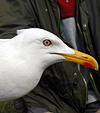 Lesser Black-backed Gull graellsii 79 adult, 2005, 2013 & 2014, Dordrecht & Moerdijk, the Netherlands. Picture: Merijn Loeve & Muusse brothers.
Lesser Black-backed Gull graellsii 79 adult, 2005, 2013 & 2014, Dordrecht & Moerdijk, the Netherlands. Picture: Merijn Loeve & Muusse brothers. LBBG B5 March 22 2008, Dordrecht, the Netherlands.
LBBG B5 March 22 2008, Dordrecht, the Netherlands. LBBG HE March 24 2008, Dordrecht, the Netherlands.
LBBG HE March 24 2008, Dordrecht, the Netherlands.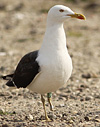 Lesser Black-backed Gull graellsii PJ adult, April 24 2015, Moerdijk, the Netherlands. Picture: Merijn Loeve.
Lesser Black-backed Gull graellsii PJ adult, April 24 2015, Moerdijk, the Netherlands. Picture: Merijn Loeve. LBBG TT March 02 2008, Dordrecht, the Netherlands.
LBBG TT March 02 2008, Dordrecht, the Netherlands. LBBG U6 April 17 2006, Moerdijk, the Netherlands.
LBBG U6 April 17 2006, Moerdijk, the Netherlands. LBBG VP April 2006 & March 2008, Dordrecht, the Netherlands.
LBBG VP April 2006 & March 2008, Dordrecht, the Netherlands. LBBG 12 March 01 2008, Dordrecht, the Netherlands.
LBBG 12 March 01 2008, Dordrecht, the Netherlands. Lesser Black-backed Gull graellsii 27 adult, May 2006 & April 2014, Moerdijk & Sassenplaat, the Netherlands. Picture: Merijn Loeve & Mars Muusse.
Lesser Black-backed Gull graellsii 27 adult, May 2006 & April 2014, Moerdijk & Sassenplaat, the Netherlands. Picture: Merijn Loeve & Mars Muusse. Lesser Black-backed Gull graellsii 35 adult, April 22 2014, Sassenplaat, the Netherlands. Picture: Merijn Loeve.
Lesser Black-backed Gull graellsii 35 adult, April 22 2014, Sassenplaat, the Netherlands. Picture: Merijn Loeve. Lesser Black-backed Gull graellsii 69 adult, May 2006 & April 2015, Moerdijk, the Netherlands. Picture: Merijn Loeve & Mars Muusse.
Lesser Black-backed Gull graellsii 69 adult, May 2006 & April 2015, Moerdijk, the Netherlands. Picture: Merijn Loeve & Mars Muusse. LBBG BH March 22 2008, Dordrecht, the Netherlands.
LBBG BH March 22 2008, Dordrecht, the Netherlands. LBBG C4 March 09 2009,Dordrecht, the Netherlands.
LBBG C4 March 09 2009,Dordrecht, the Netherlands. Lesser Black-backed Gull graellsii C6 adult, May 2006 & April 2015, Moerdijk, the Netherlands. Picture: Merijn Loeve & Mars Muusse.
Lesser Black-backed Gull graellsii C6 adult, May 2006 & April 2015, Moerdijk, the Netherlands. Picture: Merijn Loeve & Mars Muusse. LBBG JE April 09 2006, Dordrecht, the Netherlands.
LBBG JE April 09 2006, Dordrecht, the Netherlands. LBBG JX March 26 2006, Dordrecht, the Netherlands.
LBBG JX March 26 2006, Dordrecht, the Netherlands. LBBG KS March 01 2008, Dordrecht, the Netherlands.
LBBG KS March 01 2008, Dordrecht, the Netherlands. LBBG 6cy-10cy OV 2010-2014, Calais, NW France. Picture: Jean-Michel Sauvage.
LBBG 6cy-10cy OV 2010-2014, Calais, NW France. Picture: Jean-Michel Sauvage. LBBG S7 April 09 2006, Dordrecht, the Netherlands.
LBBG S7 April 09 2006, Dordrecht, the Netherlands. Lesser Black-backed Gull graellsii T6 adult, May 2005, April 2014, Moerdijk & Sassenplaat, the Netherlands. Picture: Merijn Loeve & Mars Muusse.
Lesser Black-backed Gull graellsii T6 adult, May 2005, April 2014, Moerdijk & Sassenplaat, the Netherlands. Picture: Merijn Loeve & Mars Muusse. Lesser Black-backed Gull graellsii V5 adult, April 22 2014, Sassenplaat, the Netherlands. Picture: Merijn Loeve.
Lesser Black-backed Gull graellsii V5 adult, April 22 2014, Sassenplaat, the Netherlands. Picture: Merijn Loeve. Lesser Black-backed Gull graellsii GV4T adult, April 22 2015, Sassenplaat, the Netherlands. Picture: Merijn Loeve.
Lesser Black-backed Gull graellsii GV4T adult, April 22 2015, Sassenplaat, the Netherlands. Picture: Merijn Loeve. Lesser Black-backed Gull graellsii T061 adult, May 01 2014 & April 07 2015, Maasvlakte, the Netherlands. Picture: Merijn Loeve.
Lesser Black-backed Gull graellsii T061 adult, May 01 2014 & April 07 2015, Maasvlakte, the Netherlands. Picture: Merijn Loeve. Lesser Black-backed Gull (graellsii) 1.Z 5CY, April 18 2016, Katwijk, the Netherlands.
Lesser Black-backed Gull (graellsii) 1.Z 5CY, April 18 2016, Katwijk, the Netherlands. 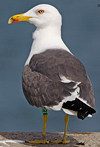 Lesser Black-backed Gull graellsii 7.2 5CY, April 08 2016, Leixões harbour, Matosinhos, Portugal. Picture: José Marques.
Lesser Black-backed Gull graellsii 7.2 5CY, April 08 2016, Leixões harbour, Matosinhos, Portugal. Picture: José Marques. 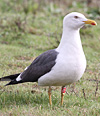 Lesser Black-backed Gull graellsii 7W 7CY-8CY, April 08 2014 & March 23 2015, Maasvlakte, the Netherlands. Picture: Merijn Loeve.
Lesser Black-backed Gull graellsii 7W 7CY-8CY, April 08 2014 & March 23 2015, Maasvlakte, the Netherlands. Picture: Merijn Loeve.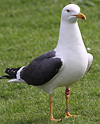 Lesser Black-backed Gull graellsii 9J 7CY, April 17 2014, Dordrecht, the Netherlands. Picture: Merijn Loeve.
Lesser Black-backed Gull graellsii 9J 7CY, April 17 2014, Dordrecht, the Netherlands. Picture: Merijn Loeve. LBBG AL March 02 2008, Dordrecht, the Netherlands.
LBBG AL March 02 2008, Dordrecht, the Netherlands.  LBBG BA March 01-02 2008, Dordrecht, the Netherlands.
LBBG BA March 01-02 2008, Dordrecht, the Netherlands. LBBG G4 March 02 2008, Dordrecht, the Netherlands.
LBBG G4 March 02 2008, Dordrecht, the Netherlands. LBBG J5 March 02 2008, Dordrecht, the Netherlands.
LBBG J5 March 02 2008, Dordrecht, the Netherlands. Lesser Black-backed Gull graellsii G* adult, April 2012 & February 2015, Maasvlakte & Rotterdam, the Netherlands. Picture: Merijn Loeve & Maarten van Kleinwee.
Lesser Black-backed Gull graellsii G* adult, April 2012 & February 2015, Maasvlakte & Rotterdam, the Netherlands. Picture: Merijn Loeve & Maarten van Kleinwee.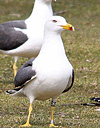 Lesser Black-backed Gull graellsii SA adult, April 08 2013, Dordrecht, the Netherlands. Picture: Merijn Loeve.
Lesser Black-backed Gull graellsii SA adult, April 08 2013, Dordrecht, the Netherlands. Picture: Merijn Loeve. Lesser Black-backed Gull graellsii 1F 10CY, April 24 2015, Moerdijk, the Netherlands. Picture: Merijn Loeve.
Lesser Black-backed Gull graellsii 1F 10CY, April 24 2015, Moerdijk, the Netherlands. Picture: Merijn Loeve.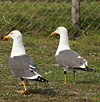 Lesser Black-backed Gull graellsii B= adult & partner B0 adult, April 07 & 20 2015, Maasvlakte - Europoort, the Netherlands. Picture: Merijn Loeve.
Lesser Black-backed Gull graellsii B= adult & partner B0 adult, April 07 & 20 2015, Maasvlakte - Europoort, the Netherlands. Picture: Merijn Loeve.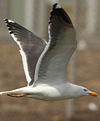 Lesser Black-backed Gull graellsii B3 adult, March 26 & April 20 2015, Maasvlakte - Europoort, the Netherlands. Picture: Merijn Loeve.
Lesser Black-backed Gull graellsii B3 adult, March 26 & April 20 2015, Maasvlakte - Europoort, the Netherlands. Picture: Merijn Loeve.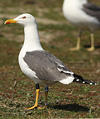 Lesser Black-backed Gull graellsii B4 adult, April 14 2015, Maasvlakte - Europoort, the Netherlands. Picture: Merijn Loeve.
Lesser Black-backed Gull graellsii B4 adult, April 14 2015, Maasvlakte - Europoort, the Netherlands. Picture: Merijn Loeve. Lesser Black-backed Gull graellsii BX adult, April 10 & June 08 2015, Maasvlakte - Europoort, the Netherlands. Picture: Merijn Loeve.
Lesser Black-backed Gull graellsii BX adult, April 10 & June 08 2015, Maasvlakte - Europoort, the Netherlands. Picture: Merijn Loeve.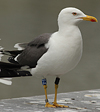 Lesser Black-backed Gull graellsii C7 adult, April 07 2015, Rotterdam, the Netherlands. Picture: Merijn Loeve.
Lesser Black-backed Gull graellsii C7 adult, April 07 2015, Rotterdam, the Netherlands. Picture: Merijn Loeve.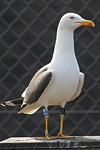 Lesser Black-backed Gull graellsii CM adult, April 07 2015, Maasvlakte - Europoort, the Netherlands. Picture: Merijn Loeve.
Lesser Black-backed Gull graellsii CM adult, April 07 2015, Maasvlakte - Europoort, the Netherlands. Picture: Merijn Loeve. Lesser Black-backed Gull graellsii DJ adult, April 07 2015, Maasvlakte - Europoort, the Netherlands. Picture: Merijn Loeve.
Lesser Black-backed Gull graellsii DJ adult, April 07 2015, Maasvlakte - Europoort, the Netherlands. Picture: Merijn Loeve. Lesser Black-backed Gull graellsii DP adult, April 10 2015, Maasvlakte - Europoort, the Netherlands. Picture: Merijn Loeve.
Lesser Black-backed Gull graellsii DP adult, April 10 2015, Maasvlakte - Europoort, the Netherlands. Picture: Merijn Loeve. Lesser Black-backed Gull graellsii E.Z 8CY, April 2012, Maasvlakte, the Netherlands.
Lesser Black-backed Gull graellsii E.Z 8CY, April 2012, Maasvlakte, the Netherlands. Lesser Black-backed Gull graellsii LS adult, April 14 2014, Dordrecht, the Netherlands. Picture: Merijn Loeve.
Lesser Black-backed Gull graellsii LS adult, April 14 2014, Dordrecht, the Netherlands. Picture: Merijn Loeve. Lesser Black-backed Gull graellsii K.XAX 4CY & 6CY, June 2013 & April 2015, Noordwijk & Maasvlakte, the Netherlands. Picture: Merijn Loeve & Mars Muusse.
Lesser Black-backed Gull graellsii K.XAX 4CY & 6CY, June 2013 & April 2015, Noordwijk & Maasvlakte, the Netherlands. Picture: Merijn Loeve & Mars Muusse. Lesser Black-backed Gull graellsii PCNU 8CY, April 24 2015, Moerdijk, the Netherlands. Picture: Merijn Loeve.
Lesser Black-backed Gull graellsii PCNU 8CY, April 24 2015, Moerdijk, the Netherlands. Picture: Merijn Loeve.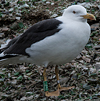 Lesser Black-backed Gull graellsii Y.BNS adult, March 28 2015, Leixões harbour, Matosinhos, Portugal. Picture: José Marques.
Lesser Black-backed Gull graellsii Y.BNS adult, March 28 2015, Leixões harbour, Matosinhos, Portugal. Picture: José Marques. Lesser Black-backed Gull graellsii E C77 10CY-11CY, April 2012 & June 2013, Maasvlakte & Dordrecht, the Netherlands. Picture: Merijn Loeve & Maarten van Kleinwee.
Lesser Black-backed Gull graellsii E C77 10CY-11CY, April 2012 & June 2013, Maasvlakte & Dordrecht, the Netherlands. Picture: Merijn Loeve & Maarten van Kleinwee.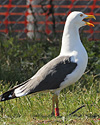 Lesser Black-backed Gull graellsii E B 11CY & 14CY, April 01 2012 & March 26 - April 10 2015, Maasvlakte, the Netherlands. Picture: Merijn Loeve & Maarten van Kleinwee.
Lesser Black-backed Gull graellsii E B 11CY & 14CY, April 01 2012 & March 26 - April 10 2015, Maasvlakte, the Netherlands. Picture: Merijn Loeve & Maarten van Kleinwee. LBBG 6CY NLA 5.426.470 April 22 2014, Calais, NW France. Picture: Jean-Michel Sauvage.
LBBG 6CY NLA 5.426.470 April 22 2014, Calais, NW France. Picture: Jean-Michel Sauvage. LBBG AH1 11cy, April 29 2002, Maasvlakte, the Netherlands, (51.59N,04.02E).
LBBG AH1 11cy, April 29 2002, Maasvlakte, the Netherlands, (51.59N,04.02E). LBBG AM0 10cy, April 16 2001 & April 29 2002, Missouriweg Maasvlakte, the Netherlands (51.59N,04.02E). Ringed June 28 1992 as pullus at the nest.
LBBG AM0 10cy, April 16 2001 & April 29 2002, Missouriweg Maasvlakte, the Netherlands (51.59N,04.02E). Ringed June 28 1992 as pullus at the nest. LBBG CH9 11cy, March 18 2002, Missouriweg, Maasvlakte, the Netherlands (51.59N,04.02E). An adult male ringed, left orange CH9, ringed as a pullus in July 1992.
LBBG CH9 11cy, March 18 2002, Missouriweg, Maasvlakte, the Netherlands (51.59N,04.02E). An adult male ringed, left orange CH9, ringed as a pullus in July 1992.  Yellow-legged
Gull CU9 13+cy (L. michahellis), Missouriweg - Maasvlakte, the Netherlands, April 29 2002 (51.59N,04.02E).
Yellow-legged
Gull CU9 13+cy (L. michahellis), Missouriweg - Maasvlakte, the Netherlands, April 29 2002 (51.59N,04.02E).
 LBBG EM710cy, March 18 2002, Missouriweg, Maasvlakte, the Netherlands (51.59N,04.02E). An adult male ringed, left orange EM7.
LBBG EM710cy, March 18 2002, Missouriweg, Maasvlakte, the Netherlands (51.59N,04.02E). An adult male ringed, left orange EM7. LBBG JX510cy, April 22 2002, Missouriweg - ECT, Maasvlakte, the Netherlands (51.59N,04.02E). An adult ringed, left orange JX5. The orange colour turned grey. Ringed July 04 1993.
LBBG JX510cy, April 22 2002, Missouriweg - ECT, Maasvlakte, the Netherlands (51.59N,04.02E). An adult ringed, left orange JX5. The orange colour turned grey. Ringed July 04 1993. LBBG KR511cy, April 06 2003, Missouriweg, Maasvlakte, the Netherlands (51.59N,04.02E). The orange colour turned grey. Ringed July 07 1993.
LBBG KR511cy, April 06 2003, Missouriweg, Maasvlakte, the Netherlands (51.59N,04.02E). The orange colour turned grey. Ringed July 07 1993. LBBG UA8 7cy, Maasvlakte, the Netherlands (51.59N,04.02E), April 05 & 14 1999. Photo by Pim Wolf.
LBBG UA8 7cy, Maasvlakte, the Netherlands (51.59N,04.02E), April 05 & 14 1999. Photo by Pim Wolf. LBBG UP8 10cy, Missouriweg - Maasvlakte, the Netherlands (51.59N,04.02E), April 29 2002.
LBBG UP8 10cy, Missouriweg - Maasvlakte, the Netherlands (51.59N,04.02E), April 29 2002.
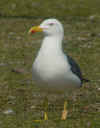 LBBG E017 8cy, April 22 2002, Missouriweg - ECT, Maasvlakte, the Netherlands (51.59N,04.02E). An adult ringed, left orange E017 in July 1995 at Maasvlakte.
LBBG E017 8cy, April 22 2002, Missouriweg - ECT, Maasvlakte, the Netherlands (51.59N,04.02E). An adult ringed, left orange E017 in July 1995 at Maasvlakte. LBBG E053 9cy, April 06 2003, Missouriweg, Maasvlakte, the Netherlands (51.59N,04.02E).
LBBG E053 9cy, April 06 2003, Missouriweg, Maasvlakte, the Netherlands (51.59N,04.02E). LBBG 12cy E113 April 22 2006, Dordrecht, the Netherlands. Pullus 07 July 1995.
LBBG 12cy E113 April 22 2006, Dordrecht, the Netherlands. Pullus 07 July 1995. LBBG 8-9cy E264 April 22 2002 & April 05 2003, Maasvlakte, the Netherlands. Pullus 08 July 1995.
LBBG 8-9cy E264 April 22 2002 & April 05 2003, Maasvlakte, the Netherlands. Pullus 08 July 1995. LBBG 12cy E282 April 22 2006, Dordrecht, the Netherlands.
LBBG 12cy E282 April 22 2006, Dordrecht, the Netherlands. LBBG E303 9cy, April 06 2003, Missouriweg, Maasvlakte, the Netherlands (51.59N,04.02E). An adult female ringed, left orange E303, ringed on 08 July 1995.
LBBG E303 9cy, April 06 2003, Missouriweg, Maasvlakte, the Netherlands (51.59N,04.02E). An adult female ringed, left orange E303, ringed on 08 July 1995. LBBG E342 8cy, March 18 2002, Nachtegalenkeet, Maasvlakte, the Netherlands (51.59N,04.02E). An adult male ringed, left orange E342, July 8 1995.
LBBG E342 8cy, March 18 2002, Nachtegalenkeet, Maasvlakte, the Netherlands (51.59N,04.02E). An adult male ringed, left orange E342, July 8 1995.  LBBG E400 5cy, Maasvlakte, the Netherlands (51.59N,04.02E), April 14 1999. Photo by Pim Wolf. Ringed at Maasvlakte in July 1995.
LBBG E400 5cy, Maasvlakte, the Netherlands (51.59N,04.02E), April 14 1999. Photo by Pim Wolf. Ringed at Maasvlakte in July 1995.
 LBBG E403 10cy, April 13 2004, Maasvlakte, the Netherlands (51.59N,04.02E). Ringed as pullus at Maasvlakte on July 08 1995.
LBBG E403 10cy, April 13 2004, Maasvlakte, the Netherlands (51.59N,04.02E). Ringed as pullus at Maasvlakte on July 08 1995. LBBG E600 8cy, Nachtegalenkeet, Maasvlakte, the Netherlands (51.59N,04.02E), March 30 2002.
LBBG E600 8cy, Nachtegalenkeet, Maasvlakte, the Netherlands (51.59N,04.02E), March 30 2002.
 LBBG E603 8cy, April 22 2002, Missouriweg - ECT, Maasvlakte, the Netherlands (51.59N,04.02E). An adult ringed, left orange E603. Ringed in 1995.
LBBG E603 8cy, April 22 2002, Missouriweg - ECT, Maasvlakte, the Netherlands (51.59N,04.02E). An adult ringed, left orange E603. Ringed in 1995. LBBG E623 9cy, April 05 2003, Lyondell, Maasvlakte, the Netherlands (51.59N,04.02E). Probably an adult female ringed, left orange E623, ringed on 09 July 1995.
LBBG E623 9cy, April 05 2003, Lyondell, Maasvlakte, the Netherlands (51.59N,04.02E). Probably an adult female ringed, left orange E623, ringed on 09 July 1995. LBBG E702 9cy, April 05 2003, Missouriweg - Maasvlakte, the Netherlands (51.59N,04.02E). Ringed left orange E702, ringed on 09 July 1995.
LBBG E702 9cy, April 05 2003, Missouriweg - Maasvlakte, the Netherlands (51.59N,04.02E). Ringed left orange E702, ringed on 09 July 1995. LBBG E832 5cy , Maasvlakte, the Netherlands (51.59N,04.02E), April 14 1999. Photo by Pim Wolf. Ringed in 1995.
LBBG E832 5cy , Maasvlakte, the Netherlands (51.59N,04.02E), April 14 1999. Photo by Pim Wolf. Ringed in 1995. LBBG E919 9cy , Missouriweg - Maasvlakte, the Netherlands (51.59N,04.02E), April 14 1999. Ringed on July 10 1995.
LBBG E919 9cy , Missouriweg - Maasvlakte, the Netherlands (51.59N,04.02E), April 14 1999. Ringed on July 10 1995. LBBG E920 8cy, March 18 2002, Missouriweg, Maasvlakte, the Netherlands (51.59N,04.02E).
LBBG E920 8cy, March 18 2002, Missouriweg, Maasvlakte, the Netherlands (51.59N,04.02E).  LBBG EA11 7cy, April 22 2002, Missouriweg - ECT, Maasvlakte, the Netherlands (51.59N,04.02E). An adult ringed left orange EA11 in 1996 as a pullus.
LBBG EA11 7cy, April 22 2002, Missouriweg - ECT, Maasvlakte, the Netherlands (51.59N,04.02E). An adult ringed left orange EA11 in 1996 as a pullus.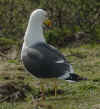 LBBG EA44 7cy, April 22 2002, Missouriweg - ECT, Maasvlakte, the Netherlands (51.59N,04.02E). An adult ringed, left orange EA44, the same date as EA11.
LBBG EA44 7cy, April 22 2002, Missouriweg - ECT, Maasvlakte, the Netherlands (51.59N,04.02E). An adult ringed, left orange EA44, the same date as EA11. LBBG EA90 9cy, April 13 2004, EMO, Maasvlakte, the Netherlands (51.59N 04.02E).
LBBG EA90 9cy, April 13 2004, EMO, Maasvlakte, the Netherlands (51.59N 04.02E). LBBG EC40 7cy, Missouriweg, Maasvlakte, the Netherlands (51.59N,04.02E), March 30 2002. An adult bird ringed left orange EC40. This is probably a male, as the dominant expression suggests.
LBBG EC40 7cy, Missouriweg, Maasvlakte, the Netherlands (51.59N,04.02E), March 30 2002. An adult bird ringed left orange EC40. This is probably a male, as the dominant expression suggests.
 Lesser Black-backed Gull graellsii EE23 15CY & 21CY, March 2010 & April 2016, IJmuiden, the Netherlands. Picture: Mars Muusse & Jan Zorgdrager.
Lesser Black-backed Gull graellsii EE23 15CY & 21CY, March 2010 & April 2016, IJmuiden, the Netherlands. Picture: Mars Muusse & Jan Zorgdrager.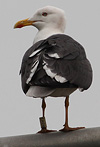 Lesser Black-backed Gull graellsii EH26 20CY, April 28 2014, Gouda, the Netherlands. Picture: Merijn Loeve.
Lesser Black-backed Gull graellsii EH26 20CY, April 28 2014, Gouda, the Netherlands. Picture: Merijn Loeve. LBBG EH79, April 16 2001 & April 06 2003, Missouriweg Maasvlakte, the Netherlands (51.59N,04.02E). Ringed July 10 1995.
LBBG EH79, April 16 2001 & April 06 2003, Missouriweg Maasvlakte, the Netherlands (51.59N,04.02E). Ringed July 10 1995.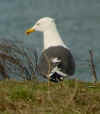 LBBG EK85, April 06 2003, Missouriweg Maasvlakte, the Netherlands (51.59N,04.02E). Ringed July 10 1995.
LBBG EK85, April 06 2003, Missouriweg Maasvlakte, the Netherlands (51.59N,04.02E). Ringed July 10 1995. LBBG EL107cy, April 19 2003, Nachtegalenkeet, Maasvlakte, the Netherlands (51.59N,04.02E). Ringed July 03 1997.
LBBG EL107cy, April 19 2003, Nachtegalenkeet, Maasvlakte, the Netherlands (51.59N,04.02E). Ringed July 03 1997. LBBG EL83 7cy, Missouriweg - Maasvlakte, the Netherlands (51.59N,04.02E), April 29 2002.
LBBG EL83 7cy, Missouriweg - Maasvlakte, the Netherlands (51.59N,04.02E), April 29 2002. 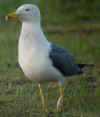 LBBG EM40 7cy, Missouriweg - Maasvlakte, the Netherlands (51.59N,04.02E), April 29 2002. An adult bird ringed left orange EM40, ringed as pullus at the nest, July 10 1996, now in 7cy.
LBBG EM40 7cy, Missouriweg - Maasvlakte, the Netherlands (51.59N,04.02E), April 29 2002. An adult bird ringed left orange EM40, ringed as pullus at the nest, July 10 1996, now in 7cy.  LBBG EM79 6cy, April 16 2001, ECT centrale Maasvlakte (51.59N,04.02E), the Netherlands. Ringed July 10 1996. This is probably a female.
LBBG EM79 6cy, April 16 2001, ECT centrale Maasvlakte (51.59N,04.02E), the Netherlands. Ringed July 10 1996. This is probably a female. LBBG EN247cy, April 22 2002, Missouriweg - ECT, Maasvlakte, the Netherlands (51.59N,04.02E).
LBBG EN247cy, April 22 2002, Missouriweg - ECT, Maasvlakte, the Netherlands (51.59N,04.02E).  LBBG EN84, March 18 2002 & April 05 2003, Missouriweg, Maasvlakte, the Netherlands (51.59N,04.02E). An adult ringed, left orange EN 84. Ringed July 13 1996.
LBBG EN84, March 18 2002 & April 05 2003, Missouriweg, Maasvlakte, the Netherlands (51.59N,04.02E). An adult ringed, left orange EN 84. Ringed July 13 1996. LBBG EP686cy, April 22 2002, Missouriweg - ECT, Maasvlakte, the Netherlands (51.59N,04.02E).
LBBG EP686cy, April 22 2002, Missouriweg - ECT, Maasvlakte, the Netherlands (51.59N,04.02E). 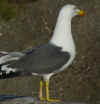 LBBG EP97 6cy, Missouriweg - Maasvlakte, the Netherlands (51.59N,04.02E), April 29 2002. An adult bird ringed left orange EP97, ringed as pullus at the nest, July 2 1997, now in 6cy.
LBBG EP97 6cy, Missouriweg - Maasvlakte, the Netherlands (51.59N,04.02E), April 29 2002. An adult bird ringed left orange EP97, ringed as pullus at the nest, July 2 1997, now in 6cy.  LBBG ET489cy, April 26 2004, EMO - Maasvlakte, the Netherlands (51.59N 04.02E). Ringed 08 July 1996.
LBBG ET489cy, April 26 2004, EMO - Maasvlakte, the Netherlands (51.59N 04.02E). Ringed 08 July 1996. LBBG ET57 7cy, April 22 2002, Nachtegalenkeet, Maasvlakte, the Netherlands (51.59N,04.02E).
LBBG ET57 7cy, April 22 2002, Nachtegalenkeet, Maasvlakte, the Netherlands (51.59N,04.02E). 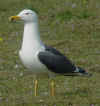 LBBG EU736cy, April 22 2002, Missouriweg - ECT, Maasvlakte, the Netherlands (51.59N,04.02E). An adult ringed, left orange EU73. This bird was ringed July 2 1997.
LBBG EU736cy, April 22 2002, Missouriweg - ECT, Maasvlakte, the Netherlands (51.59N,04.02E). An adult ringed, left orange EU73. This bird was ringed July 2 1997. LBBG EV246cy, April 22 2002, Missouriweg - ECT, Maasvlakte, the Netherlands (51.59N,04.02E).
LBBG EV246cy, April 22 2002, Missouriweg - ECT, Maasvlakte, the Netherlands (51.59N,04.02E).  LBBG EV83 6cy, April 22 2002, Nachtegalenkeet, Maasvlakte, the Netherlands (51.59N,04.02E).
LBBG EV83 6cy, April 22 2002, Nachtegalenkeet, Maasvlakte, the Netherlands (51.59N,04.02E). 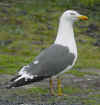 LBBG EX148cy, April 13 2004, EMO, Maasvlakte, the Netherlands (51.59N 04.02E). Ringed 03 July 1997.
LBBG EX148cy, April 13 2004, EMO, Maasvlakte, the Netherlands (51.59N 04.02E). Ringed 03 July 1997. LBBG EY687cy, April 06 2003, Nachtegalenkeet, Maasvlakte, the Netherlands (51.59N,04.02E).
LBBG EY687cy, April 06 2003, Nachtegalenkeet, Maasvlakte, the Netherlands (51.59N,04.02E). LBBG EAL18cy, April 26 2004, EMO Maasvlakte, the Netherlands (51.59N 04.02E). Ringed 04 July 1997.
LBBG EAL18cy, April 26 2004, EMO Maasvlakte, the Netherlands (51.59N 04.02E). Ringed 04 July 1997. 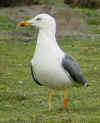 LBBG EAY015cy, March 18 & April 22 2002, Missouriweg, Maasvlakte, the Netherlands (51.59N,04.02E). The first of birds An adult ringed, left orange EAY0, originating from Britain, ringed in 1988.
LBBG EAY015cy, March 18 & April 22 2002, Missouriweg, Maasvlakte, the Netherlands (51.59N,04.02E). The first of birds An adult ringed, left orange EAY0, originating from Britain, ringed in 1988. 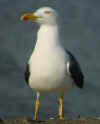 LBBG ECC2 6cy, Missouriweg - Maasvlakte, the Netherlands (51.59N,04.02E), April 29 2002. An adult bird ringed left orange ECC2, ringed as pullus at the nest, July 3 1997, now in 6cy.
LBBG ECC2 6cy, Missouriweg - Maasvlakte, the Netherlands (51.59N,04.02E), April 29 2002. An adult bird ringed left orange ECC2, ringed as pullus at the nest, July 3 1997, now in 6cy.
 LBBG ECL4 8cy, April 13 2004, EMO - Maasvlakte, the Netherlands (51.59N 04.02E). Ringed as pullus, July 03 1997.
LBBG ECL4 8cy, April 13 2004, EMO - Maasvlakte, the Netherlands (51.59N 04.02E). Ringed as pullus, July 03 1997. LBBG MU6 adult, Missouriweg, Maasvlakte, the Netherlands (51.59N,04.02E), March 30 2002. An adult bird ringed left leg orange MU6.
LBBG MU6 adult, Missouriweg, Maasvlakte, the Netherlands (51.59N,04.02E), March 30 2002. An adult bird ringed left leg orange MU6.
 LBBG NP8 8cy, April 29 2004, Missouriweg, Maasvlakte, the Netherlands (51.59N 04.02E). Ringed 11 July 1997.
LBBG NP8 8cy, April 29 2004, Missouriweg, Maasvlakte, the Netherlands (51.59N 04.02E). Ringed 11 July 1997. LBBG NT0 6cy, March 18 2002, Missouriweg, Maasvlakte, the Netherlands (51.59N,04.02E). An adult female ringed, left orange NT0 in white letters.
LBBG NT0 6cy, March 18 2002, Missouriweg, Maasvlakte, the Netherlands (51.59N,04.02E). An adult female ringed, left orange NT0 in white letters. 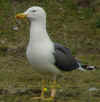 LBBG NU6 6cy, April 22 2002, Missouriweg - ECT, Maasvlakte, the Netherlands (51.59N,04.02E). An adult ringed, left orange with a white code NU6. Ringed the same date as NT0.
LBBG NU6 6cy, April 22 2002, Missouriweg - ECT, Maasvlakte, the Netherlands (51.59N,04.02E). An adult ringed, left orange with a white code NU6. Ringed the same date as NT0.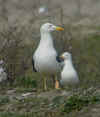 LBBG NX5 6cy, April 22 2002, Missouriweg - ECT, Maasvlakte, the Netherlands (51.59N,04.02E). An adult ringed, left orange with a white code NX5. Ringed as pullus, July 12 1997.
LBBG NX5 6cy, April 22 2002, Missouriweg - ECT, Maasvlakte, the Netherlands (51.59N,04.02E). An adult ringed, left orange with a white code NX5. Ringed as pullus, July 12 1997. LBBG PA4 6cy, Missouriweg - Maasvlakte, the Netherlands (51.59N,04.02E), April 29 2002. An adult bird ringed left orange with white code PA4, ringed as pullus at the nest, July 12 1997, now in 6cy.
LBBG PA4 6cy, Missouriweg - Maasvlakte, the Netherlands (51.59N,04.02E), April 29 2002. An adult bird ringed left orange with white code PA4, ringed as pullus at the nest, July 12 1997, now in 6cy.  LBBG PA8 8cy, Missouriweg - Maasvlakte, the Netherlands (51.59N,04.02E), April 13 2004. Ringed as pullus, July 12 1997.
LBBG PA8 8cy, Missouriweg - Maasvlakte, the Netherlands (51.59N,04.02E), April 13 2004. Ringed as pullus, July 12 1997. 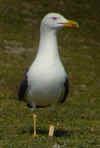 LBBG RC9 6cy, April 22 2002, Missouriweg - ECT, Maasvlakte, the Netherlands (51.59N,04.02E). An adult ringed, left orange with a white code RC9. Ringed July 11 1997.
LBBG RC9 6cy, April 22 2002, Missouriweg - ECT, Maasvlakte, the Netherlands (51.59N,04.02E). An adult ringed, left orange with a white code RC9. Ringed July 11 1997. LBBG RJ5 7cy, April 19 2003, Nachtegalenkeet - Maasvlakte, the Netherlands (51.59N,04.02E). An adult ringed, left orange with a white code RJ5. Ringed July 11 1997.
LBBG RJ5 7cy, April 19 2003, Nachtegalenkeet - Maasvlakte, the Netherlands (51.59N,04.02E). An adult ringed, left orange with a white code RJ5. Ringed July 11 1997. LBBG CC3 10cy, Dintelhaven - Maasvlakte, the Netherlands (51.59N,04.02E), April 29 2002. An adult bird ringed left green CC3, ringed as pullus at the nest, June 1993.
LBBG CC3 10cy, Dintelhaven - Maasvlakte, the Netherlands (51.59N,04.02E), April 29 2002. An adult bird ringed left green CC3, ringed as pullus at the nest, June 1993.
 LBBG EH6 11cy, April 19 2003, Nachtegalenkeet, Maasvlakte, the Netherlands (51.59N,04.02E). An adult ringed, left green EH6.
LBBG EH6 11cy, April 19 2003, Nachtegalenkeet, Maasvlakte, the Netherlands (51.59N,04.02E). An adult ringed, left green EH6. 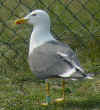 LBBG JH5 10cy, April 22 & 29 2002, Dintelhaven, Maasvlakte, the Netherlands (51.59N,04.02E). An adult ringed, left green JH5. This bird was ringed June 28 1993.
LBBG JH5 10cy, April 22 & 29 2002, Dintelhaven, Maasvlakte, the Netherlands (51.59N,04.02E). An adult ringed, left green JH5. This bird was ringed June 28 1993.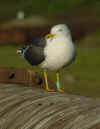 LBBG JL7 10cy, Missouriweg - Maasvlakte, the Netherlands (51.59N,04.02E), April 29 2002. An adult bird ringed left green JL7, ringed as pullus at the nest, June 21 1993, now in 10cy. Note the mirror on p10, merging with the white tip.
LBBG JL7 10cy, Missouriweg - Maasvlakte, the Netherlands (51.59N,04.02E), April 29 2002. An adult bird ringed left green JL7, ringed as pullus at the nest, June 21 1993, now in 10cy. Note the mirror on p10, merging with the white tip. LBBG LL1 2001 & 2002, ECT centrale Maasvlakte, the Netherlands (51.59N,04.02E). Ringed June 28th 1993. Probably a male.
LBBG LL1 2001 & 2002, ECT centrale Maasvlakte, the Netherlands (51.59N,04.02E). Ringed June 28th 1993. Probably a male. Lesser Black-backed Gull graellsii NP6 18CY, April 10 2015, Maasvlakte, the Netherlands. Picture: Merijn Loeve.
Lesser Black-backed Gull graellsii NP6 18CY, April 10 2015, Maasvlakte, the Netherlands. Picture: Merijn Loeve. LBBG NV4 2002 & 2004, Dintelhaven, Maasvlakte, the Netherlands (51.59N 04.02E).
LBBG NV4 2002 & 2004, Dintelhaven, Maasvlakte, the Netherlands (51.59N 04.02E).  LBBG NV7 April 13 2004, Dintelhaven, Maasvlakte, the Netherlands (51.59N,04.02E).
LBBG NV7 April 13 2004, Dintelhaven, Maasvlakte, the Netherlands (51.59N,04.02E).  LBBG PP4 April 22 2002, Dintelhaven, Maasvlakte, the Netherlands (51.59N,04.02E).
LBBG PP4 April 22 2002, Dintelhaven, Maasvlakte, the Netherlands (51.59N,04.02E).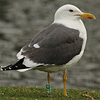 Lesser Black-backed Gull graellsii PJ2 15CY, 18CY, 19CY, September 2011, May 2014 & April 2015, the Netherlands. Picture: Merijn Loeve & Maarten van Kleinwee.
Lesser Black-backed Gull graellsii PJ2 15CY, 18CY, 19CY, September 2011, May 2014 & April 2015, the Netherlands. Picture: Merijn Loeve & Maarten van Kleinwee.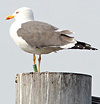 Lesser Black-backed Gull graellsii PV2 18CY-19CY, April 2014 & April 2015, Maasvlakte-Europoort, the Netherlands. Picture: Merijn Loeve.
Lesser Black-backed Gull graellsii PV2 18CY-19CY, April 2014 & April 2015, Maasvlakte-Europoort, the Netherlands. Picture: Merijn Loeve. LBBG 10cy RH0 April April 14 2006, Dordrecht, the Netherlands.
LBBG 10cy RH0 April April 14 2006, Dordrecht, the Netherlands.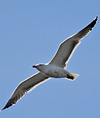 Lesser Black-backed Gull graellsii TS1 6CY & 19CY, April 2002 & April 2015, Maasvlakte-Europoort, the Netherlands. Picture: Merijn Loeve & Mars Muusse.
Lesser Black-backed Gull graellsii TS1 6CY & 19CY, April 2002 & April 2015, Maasvlakte-Europoort, the Netherlands. Picture: Merijn Loeve & Mars Muusse. LBBG E129 8cy, Dintelhaven - Maasvlakte, the Netherlands (51.59N,04.02E), April 29 2002.
LBBG E129 8cy, Dintelhaven - Maasvlakte, the Netherlands (51.59N,04.02E), April 29 2002.
 LBBG E398 8cy, March 30 2002, Dintelhaven, Maasvlakte, the Netherlands (51.59N,04.02E). This bird was ringed June 28 1995 close to the current breeding spot.
LBBG E398 8cy, March 30 2002, Dintelhaven, Maasvlakte, the Netherlands (51.59N,04.02E). This bird was ringed June 28 1995 close to the current breeding spot. LBBG E451 8cy, April 13 2004, EMO - Maasvlakte, the Netherlands (51.59N 04.02E). Ringed June 15 1995.
LBBG E451 8cy, April 13 2004, EMO - Maasvlakte, the Netherlands (51.59N 04.02E). Ringed June 15 1995. LBBG E887 9cy , April 05 2003, Missouriweg - Maasvlakte, the Netherlands (51.59N,04.02E).
LBBG E887 9cy , April 05 2003, Missouriweg - Maasvlakte, the Netherlands (51.59N,04.02E).  LBBG EE02 11cy , April 29 2004, Missouriweg - Maasvlakte, the Netherlands (51.59N 04.02E). Ringed 07 July 1994 at Maasvlakte.
LBBG EE02 11cy , April 29 2004, Missouriweg - Maasvlakte, the Netherlands (51.59N 04.02E). Ringed 07 July 1994 at Maasvlakte. LBBG ES98 7cyDintelhaven - Maasvlakte, the Netherlands (51.59N,04.02E), April 29 2002.
LBBG ES98 7cyDintelhaven - Maasvlakte, the Netherlands (51.59N,04.02E), April 29 2002.  LBBG ET17 7cy April 22 2002, Dintelhaven, Maasvlakte, the Netherlands (51.59N,04.02E). Ringed June 26 1996.
LBBG ET17 7cy April 22 2002, Dintelhaven, Maasvlakte, the Netherlands (51.59N,04.02E). Ringed June 26 1996. Lesser Black-backed Gull graellsii ET55 21CY-22CY, April 2016 & June 2017, Leixões Harbour, Matosinhos, Portugal. Picture: José Marques.
Lesser Black-backed Gull graellsii ET55 21CY-22CY, April 2016 & June 2017, Leixões Harbour, Matosinhos, Portugal. Picture: José Marques. LBBG ET79 7cyDintelhaven - Maasvlakte, the Netherlands (51.59N,04.02E), April 29 2002. Ringed as pullus June 26 1996.
LBBG ET79 7cyDintelhaven - Maasvlakte, the Netherlands (51.59N,04.02E), April 29 2002. Ringed as pullus June 26 1996.  LBBG EV39 6cy, Dintelhaven - Maasvlakte, the Netherlands (51.59N,04.02E), April 29 2002. Ringed as pullus June 21 1997, now 6cy.
LBBG EV39 6cy, Dintelhaven - Maasvlakte, the Netherlands (51.59N,04.02E), April 29 2002. Ringed as pullus June 21 1997, now 6cy.  LBBG EV416cyDintelhaven, Maasvlakte, the Netherlands (51.59N,04.02E), March 30 2002.
LBBG EV416cyDintelhaven, Maasvlakte, the Netherlands (51.59N,04.02E), March 30 2002.
 LBBG EAH9 6cyDintelhaven - Maasvlakte, the Netherlands (51.59N,04.02E), April 29 2002. Ringed as pullus at the nest, June 24 1997.
LBBG EAH9 6cyDintelhaven - Maasvlakte, the Netherlands (51.59N,04.02E), April 29 2002. Ringed as pullus at the nest, June 24 1997.
 LBBG EAK5 6cyDintelhaven - Maasvlakte, the Netherlands (51.59N,04.02E), April 29 2002. Ringed as pullus at the nest, June 24 1997, now 6cy.
LBBG EAK5 6cyDintelhaven - Maasvlakte, the Netherlands (51.59N,04.02E), April 29 2002. Ringed as pullus at the nest, June 24 1997, now 6cy.  LBBG EAS1 6cy, April 22 2002, Dintelhaven, Maasvlakte, the Netherlands (51.59N,04.02E). Ringed June 24 1997.
LBBG EAS1 6cy, April 22 2002, Dintelhaven, Maasvlakte, the Netherlands (51.59N,04.02E). Ringed June 24 1997. LBBG ECC0 6cy, Dintelhaven - Maasvlakte, the Netherlands (51.59N,04.02E), April 29 2002.
LBBG ECC0 6cy, Dintelhaven - Maasvlakte, the Netherlands (51.59N,04.02E), April 29 2002.
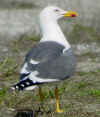 LBBG M69 13cy, Lyondell - Maasvlakte, the Netherlands (51.59N,04.02E), 05 April 2003. Left white M69, ringed as pullus at the nest, July 06 1991, now in 13cy.
LBBG M69 13cy, Lyondell - Maasvlakte, the Netherlands (51.59N,04.02E), 05 April 2003. Left white M69, ringed as pullus at the nest, July 06 1991, now in 13cy. LBBG M90 12cy,Missouriweg - Maasvlakte, the Netherlands, April 29 2002. Ringed as pullus at the nest, July 06 1991. These codes were used from the first years the ring project started in 1990 and 1991.
LBBG M90 12cy,Missouriweg - Maasvlakte, the Netherlands, April 29 2002. Ringed as pullus at the nest, July 06 1991. These codes were used from the first years the ring project started in 1990 and 1991. 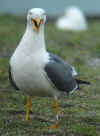 LBBG R18, Missouriweg - Maasvlakte, the Netherlands (51.59N,04.02E), April 29 2002 & April 06 2003. Ringed white R18 and a vertical T, ringed as pullus at the nest, July 06 1991. A strong bird, indicating this is a male. Note the odd shape of the p10-mirror.
LBBG R18, Missouriweg - Maasvlakte, the Netherlands (51.59N,04.02E), April 29 2002 & April 06 2003. Ringed white R18 and a vertical T, ringed as pullus at the nest, July 06 1991. A strong bird, indicating this is a male. Note the odd shape of the p10-mirror. LBBG RY9 5cy, Missouriweg - Maasvlakte, the Netherlands (51.59N,04.02E), April 29 2002. Ringed as pullus early July 1998.
LBBG RY9 5cy, Missouriweg - Maasvlakte, the Netherlands (51.59N,04.02E), April 29 2002. Ringed as pullus early July 1998. LBBG SH2 5cy, April 22 2002, Dintelhaven, Maasvlakte, the Netherlands (51.59N,04.02E). An adult ringed, left white SH2.
LBBG SH2 5cy, April 22 2002, Dintelhaven, Maasvlakte, the Netherlands (51.59N,04.02E). An adult ringed, left white SH2.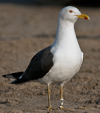 LBBG SL2 15cy, March 11 2012, Maasvlakte, the Netherlands.
LBBG SL2 15cy, March 11 2012, Maasvlakte, the Netherlands. LBBG SP3, April 22 2002, Missouriweg - ECT, Maasvlakte, the Netherlands (51.59N,04.02E). An adult ringed, left white SP3.
LBBG SP3, April 22 2002, Missouriweg - ECT, Maasvlakte, the Netherlands (51.59N,04.02E). An adult ringed, left white SP3. LBBG V11 9cy, Maasvlakte, the Netherlands (51.59N,04.02E), April 14 1999. Photo by Pim Wolf. This bird was ringed on July 08 1991.
LBBG V11 9cy, Maasvlakte, the Netherlands (51.59N,04.02E), April 14 1999. Photo by Pim Wolf. This bird was ringed on July 08 1991. LBBG V90 14cy, Maasvlakte, the Netherlands (51.59N,04.02E), April 29 2004. This bird was ringed on July 08 1991.
LBBG V90 14cy, Maasvlakte, the Netherlands (51.59N,04.02E), April 29 2004. This bird was ringed on July 08 1991. Lesser Black-backed Gull graellsii N05F adult, April 10 2015, Maasvlakte, the Netherlands. Picture: Merijn Loeve.
Lesser Black-backed Gull graellsii N05F adult, April 10 2015, Maasvlakte, the Netherlands. Picture: Merijn Loeve. LBBGxYLG hybrid? L 4 adult, April 13 2004, EMO, Maasvlakte, the Netherlands (51.59N,04.02E).
LBBGxYLG hybrid? L 4 adult, April 13 2004, EMO, Maasvlakte, the Netherlands (51.59N,04.02E). LBBG 2-- adult, April 29 2002, Dintelhaven, Maasvlakte, the Netherlands (51.59N,04.02E).
LBBG 2-- adult, April 29 2002, Dintelhaven, Maasvlakte, the Netherlands (51.59N,04.02E). intermedius 15cy =1 March 19 & 31 2011, IJmuiden, the Netherlands.
intermedius 15cy =1 March 19 & 31 2011, IJmuiden, the Netherlands.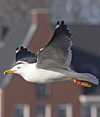 Lesser Black-backed Gull S 13-14CY, April 29 2014 & April 17 2015, Katwijk, the Netherlands.
Lesser Black-backed Gull S 13-14CY, April 29 2014 & April 17 2015, Katwijk, the Netherlands. LBBG 7S adult, April 29 2004, Dintelhaven, Maasvlakte, the Netherlands (51.59N 04.02E). Parent in the 1cy LBBG post-juvenile moult project 2004.
LBBG 7S adult, April 29 2004, Dintelhaven, Maasvlakte, the Netherlands (51.59N 04.02E). Parent in the 1cy LBBG post-juvenile moult project 2004.  LBBG J 7 adult, April 12 2001, Nachtegalenkeet Maasvlakte, the Netherlands (51.59N,04.02E). Probably an adult female, ringed J green 7 black.
LBBG J 7 adult, April 12 2001, Nachtegalenkeet Maasvlakte, the Netherlands (51.59N,04.02E). Probably an adult female, ringed J green 7 black.  LBBG --1 adult, April 13 2004, Dintelhaven, Maasvlakte, the Netherlands (51.59N,04.02E).
LBBG --1 adult, April 13 2004, Dintelhaven, Maasvlakte, the Netherlands (51.59N,04.02E). LBBG E022 6cy, April 29 2004, Missouriweg - ECT, Maasvlakte, the Netherlands (51.59N 04.02E). Ringed July 17 1999 at Maasvlakte.
LBBG E022 6cy, April 29 2004, Missouriweg - ECT, Maasvlakte, the Netherlands (51.59N 04.02E). Ringed July 17 1999 at Maasvlakte. LBBG 8cy E092 April 22 2006, Dordrecht, the Netherlands.
LBBG 8cy E092 April 22 2006, Dordrecht, the Netherlands. LBBG E136 6cy, April 13 2004, EMO, Maasvlakte, the Netherlands (51.59N 04.02E). Ringed as pullus, July 17 1999.
LBBG E136 6cy, April 13 2004, EMO, Maasvlakte, the Netherlands (51.59N 04.02E). Ringed as pullus, July 17 1999. LBBG E302 5cy, April 26 2004, Missouriweg, Maasvlakte, the Netherlands (51.59N 04.02E). Ringed as pullus, July 04 2000.
LBBG E302 5cy, April 26 2004, Missouriweg, Maasvlakte, the Netherlands (51.59N 04.02E). Ringed as pullus, July 04 2000.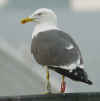 LBBG E347 5cy, April 29 2004, Nachtegalenkeet, Maasvlakte, the Netherlands (51.59N 04.02E). Ringed July 08 2000 at Maasvlakte.
LBBG E347 5cy, April 29 2004, Nachtegalenkeet, Maasvlakte, the Netherlands (51.59N 04.02E). Ringed July 08 2000 at Maasvlakte. LBBG E734 11+cy, March 24 2010, IJmuiden, the Netherlands.
LBBG E734 11+cy, March 24 2010, IJmuiden, the Netherlands. LBBG graellsii B35 E 12CY, April 07 2013, Maasvlakte, the Netherlands.
LBBG graellsii B35 E 12CY, April 07 2013, Maasvlakte, the Netherlands. LBBG B64 5cy, March 05 2006, Madrid, Spain. Picture: Delfín González.
LBBG B64 5cy, March 05 2006, Madrid, Spain. Picture: Delfín González. Lesser Black-backed Gull graellsii NLA 5.464.735 7CY, April 25 2017, Katwijk, the Netherlands.
Lesser Black-backed Gull graellsii NLA 5.464.735 7CY, April 25 2017, Katwijk, the Netherlands. Lesser Black-backed Gull graellsii 6CY & 8CY NLA 5.426.470 April 2014 & April 2016, Calais, NW France. Picture: Jean-Michel Sauvage.
Lesser Black-backed Gull graellsii 6CY & 8CY NLA 5.426.470 April 2014 & April 2016, Calais, NW France. Picture: Jean-Michel Sauvage. Lesser Black-backed Gull (graellsii) NLA 5.416.817 10CY, April 06 2016, IJmuiden, the Netherlands.
Lesser Black-backed Gull (graellsii) NLA 5.416.817 10CY, April 06 2016, IJmuiden, the Netherlands. LBBG NLA 5.248.763 adult, April 13 2004, EMO, Maasvlakte, the Netherlands (51.59N 04.02E).
LBBG NLA 5.248.763 adult, April 13 2004, EMO, Maasvlakte, the Netherlands (51.59N 04.02E). LBBG NLA 5.248.808 adult, April 05 2003, Nachtegalenkeet, Maasvlakte, the Netherlands (51.59N,04.02E).
LBBG NLA 5.248.808 adult, April 05 2003, Nachtegalenkeet, Maasvlakte, the Netherlands (51.59N,04.02E). Lesser Black-backed Gull graellsii ESI 61xxx01 adult, April & June 2017, Katwijk, the Netherlands.
Lesser Black-backed Gull graellsii ESI 61xxx01 adult, April & June 2017, Katwijk, the Netherlands. Lesser Black-backed Gull graellsii M:023 adult, April 29 2016, Leixões Harbour, Matosinhos, Portugal. Picture: José Marques.
Lesser Black-backed Gull graellsii M:023 adult, April 29 2016, Leixões Harbour, Matosinhos, Portugal. Picture: José Marques. Lesser Black-backed Gull graellsii M:071 adult, April 05 2016, Matosinhos beach, Matosinhos, Portugal. Picture: José Marques.
Lesser Black-backed Gull graellsii M:071 adult, April 05 2016, Matosinhos beach, Matosinhos, Portugal. Picture: José Marques.
















